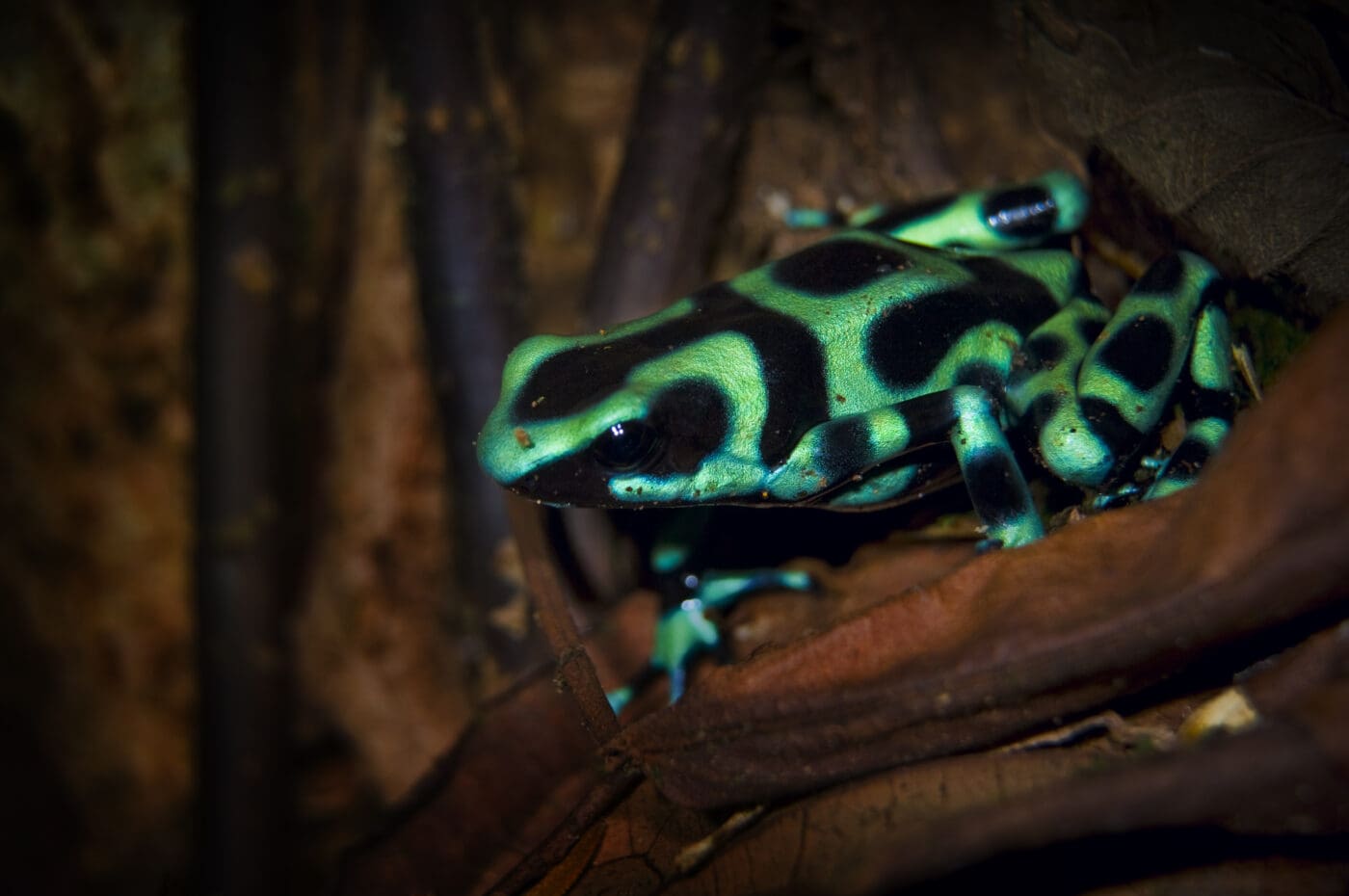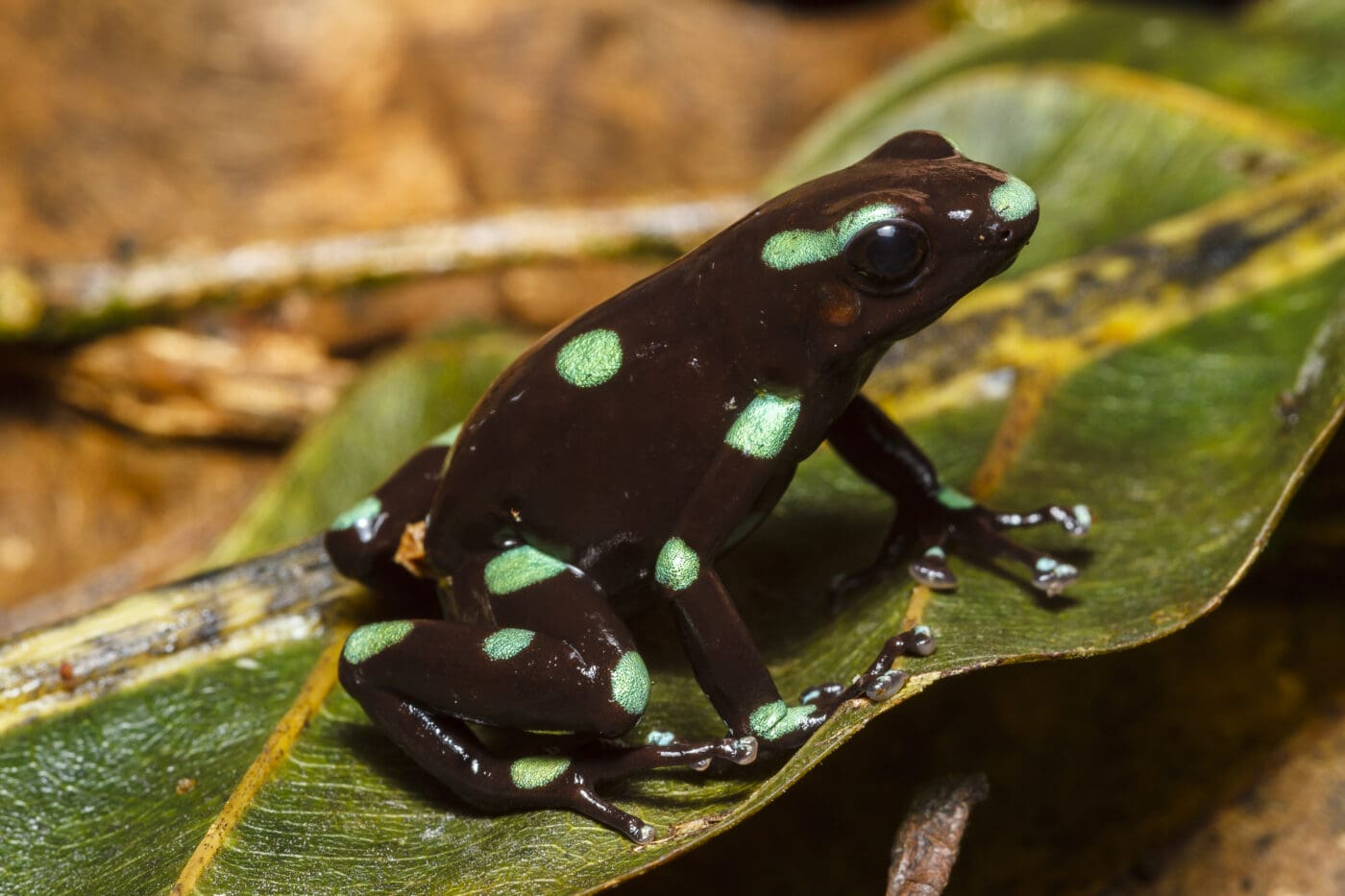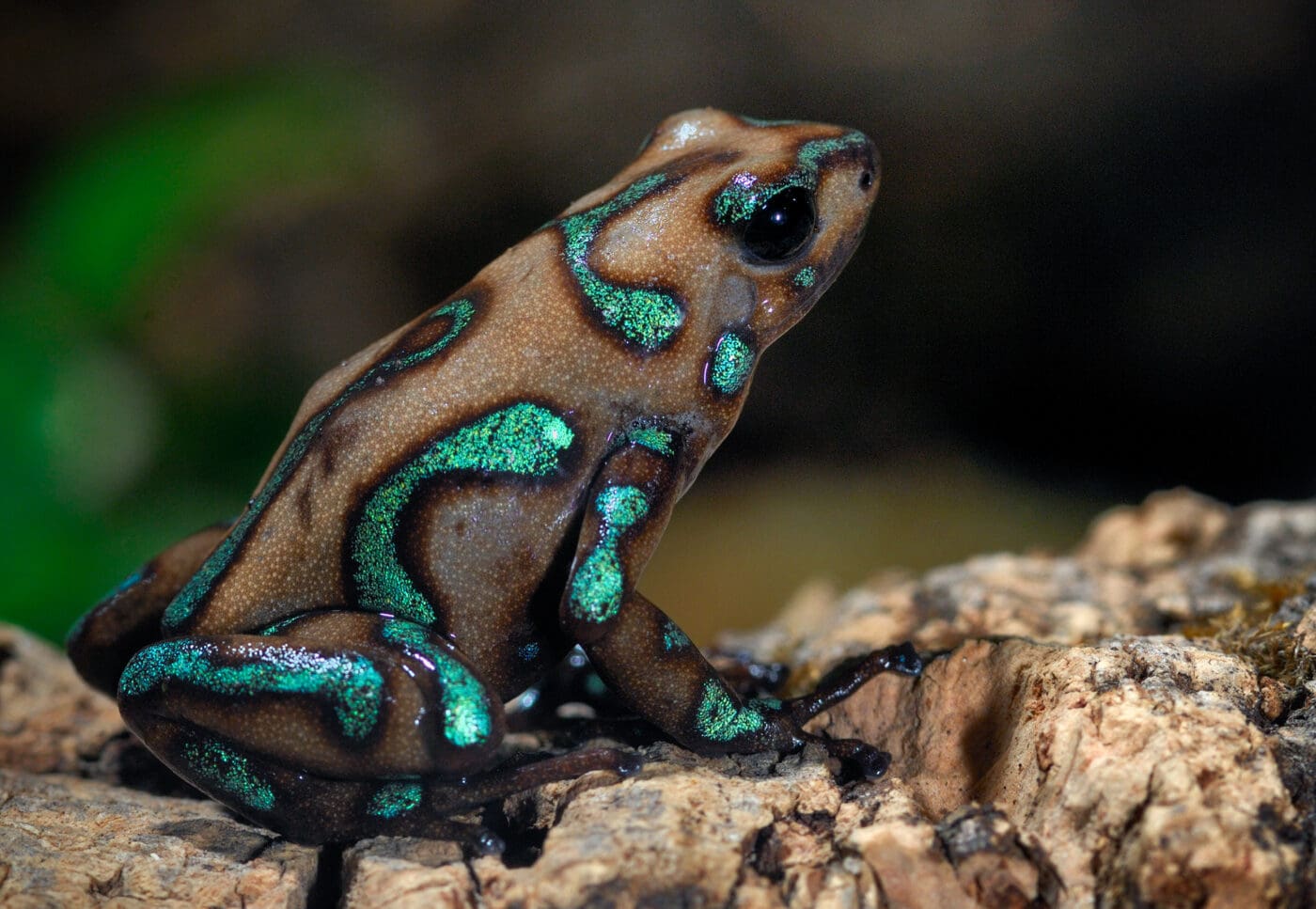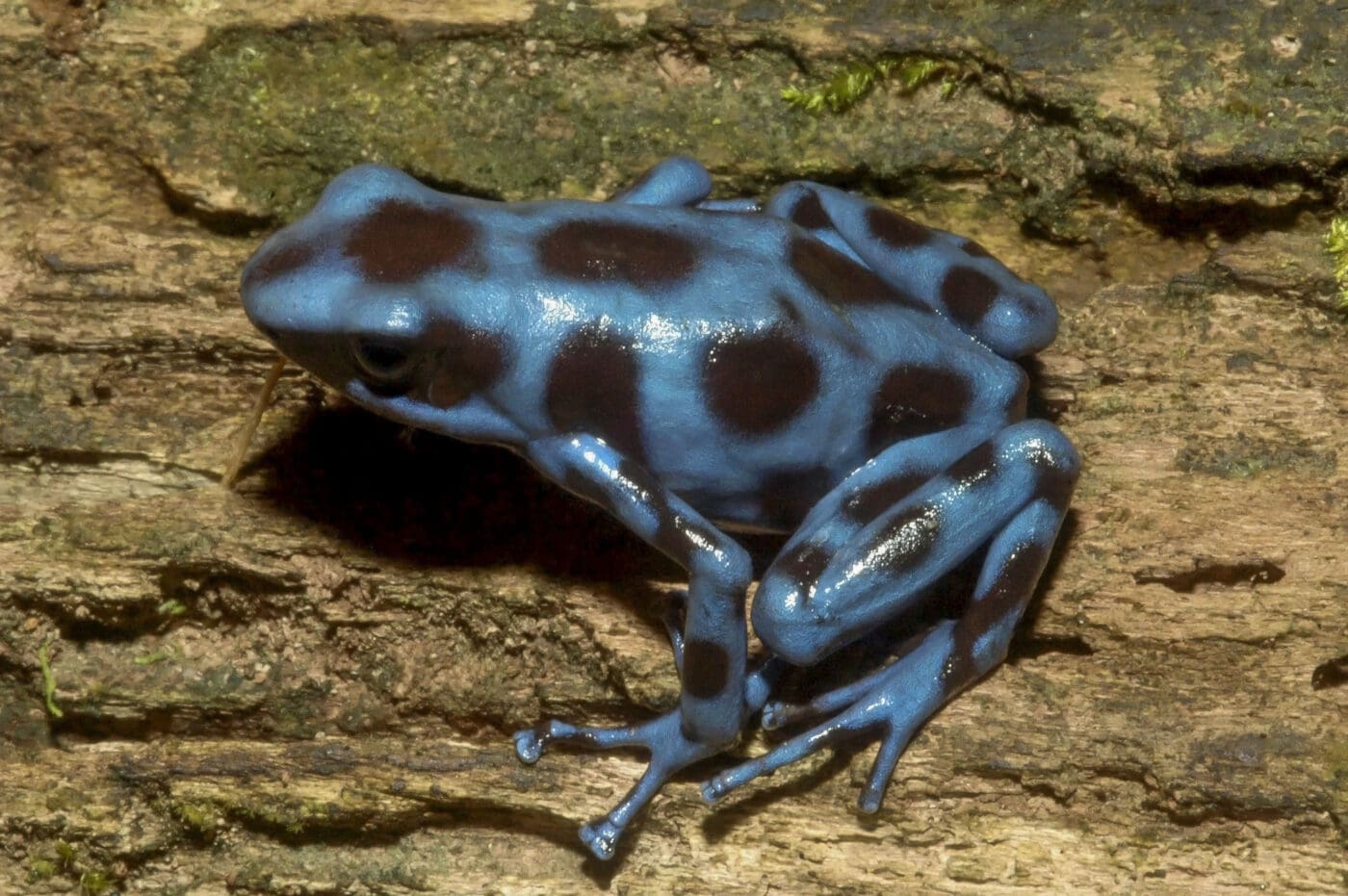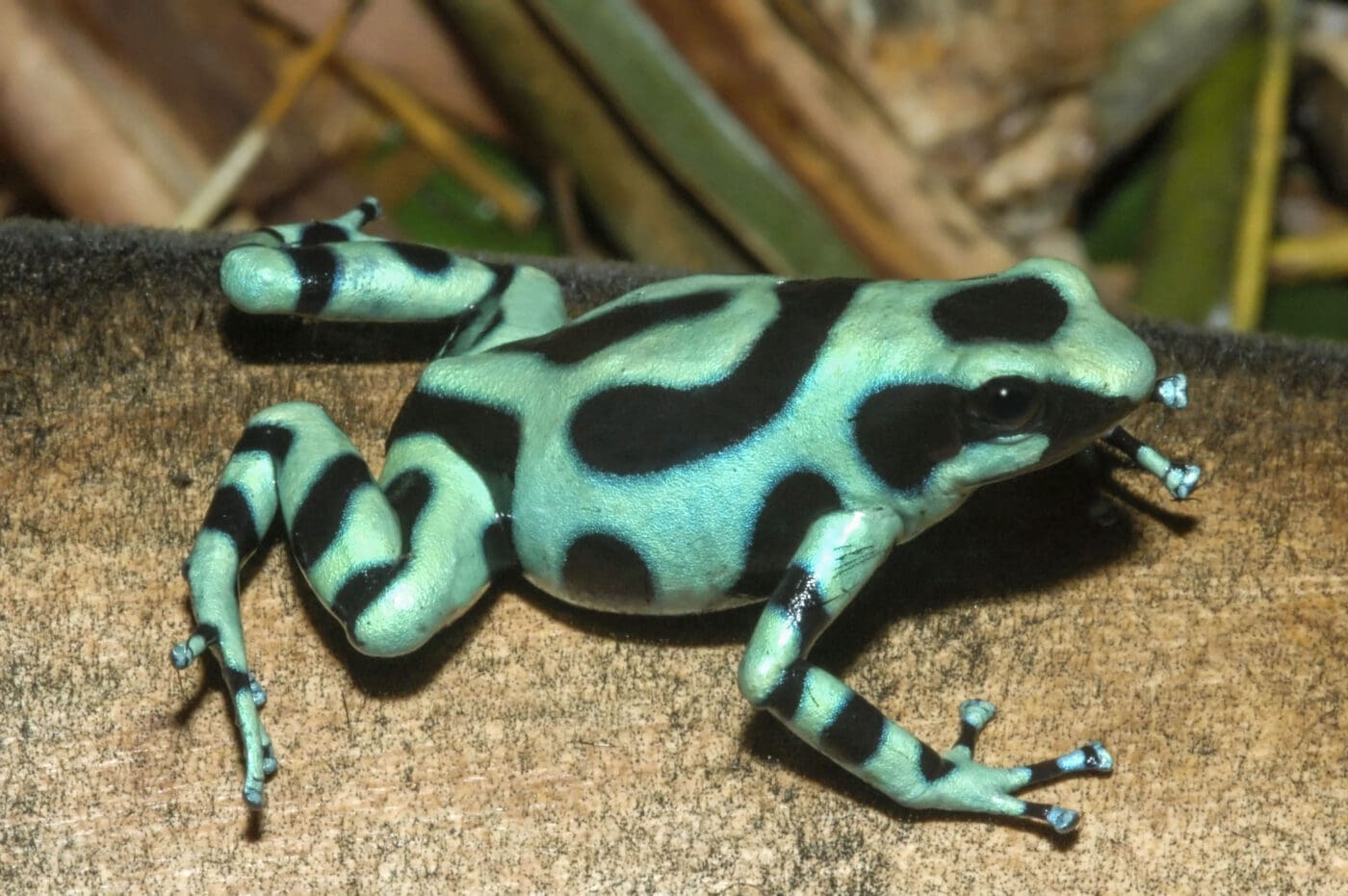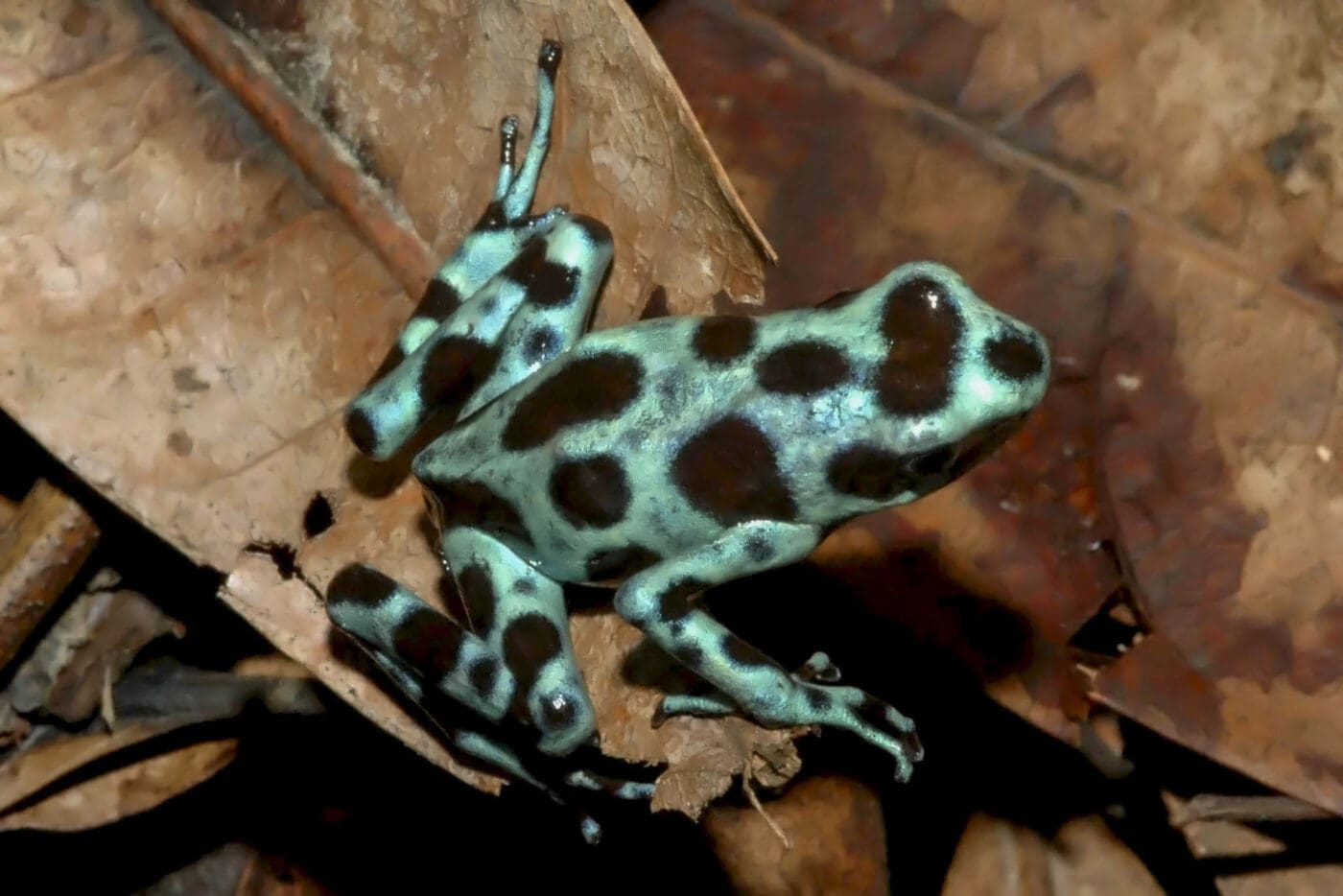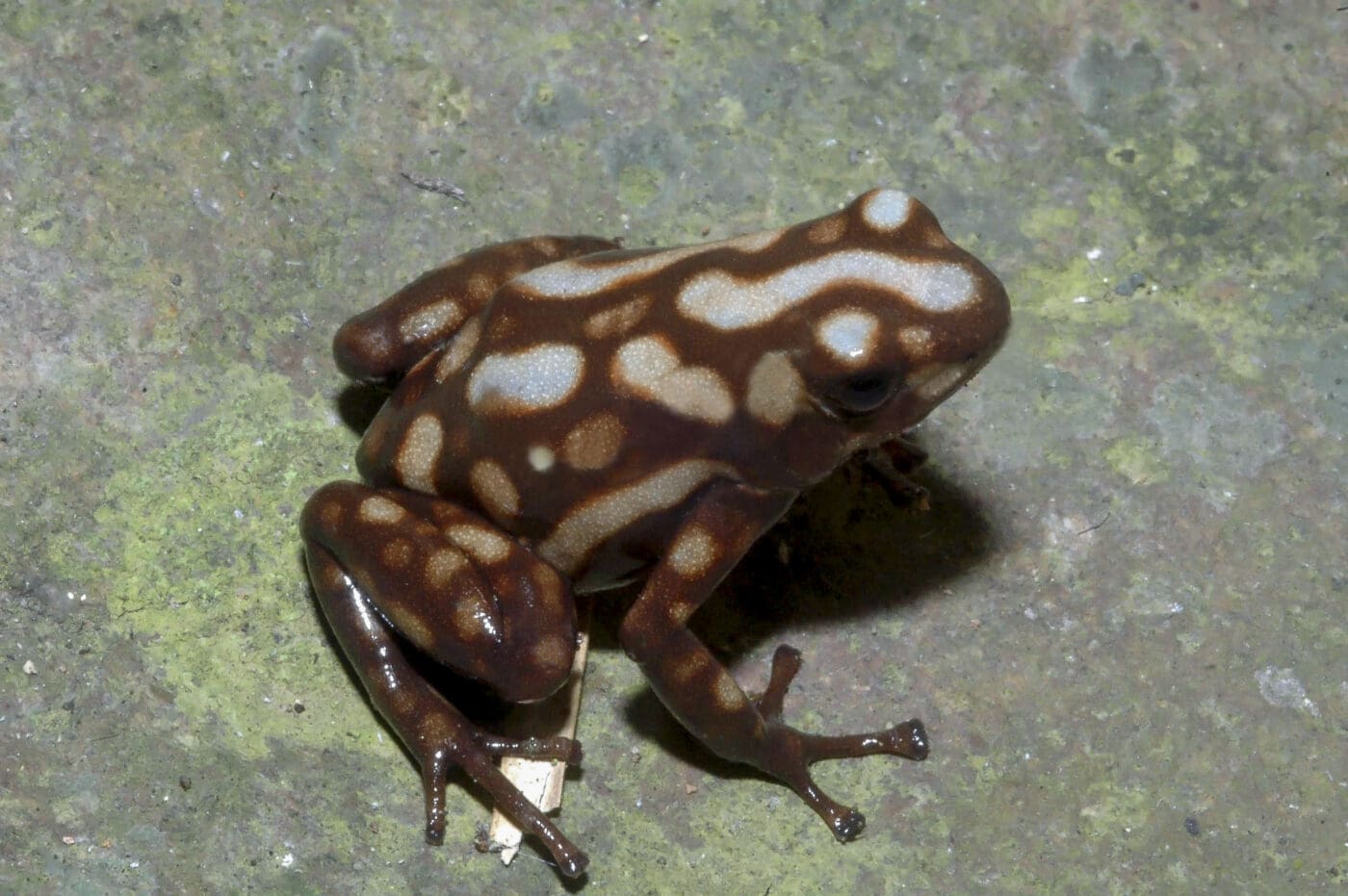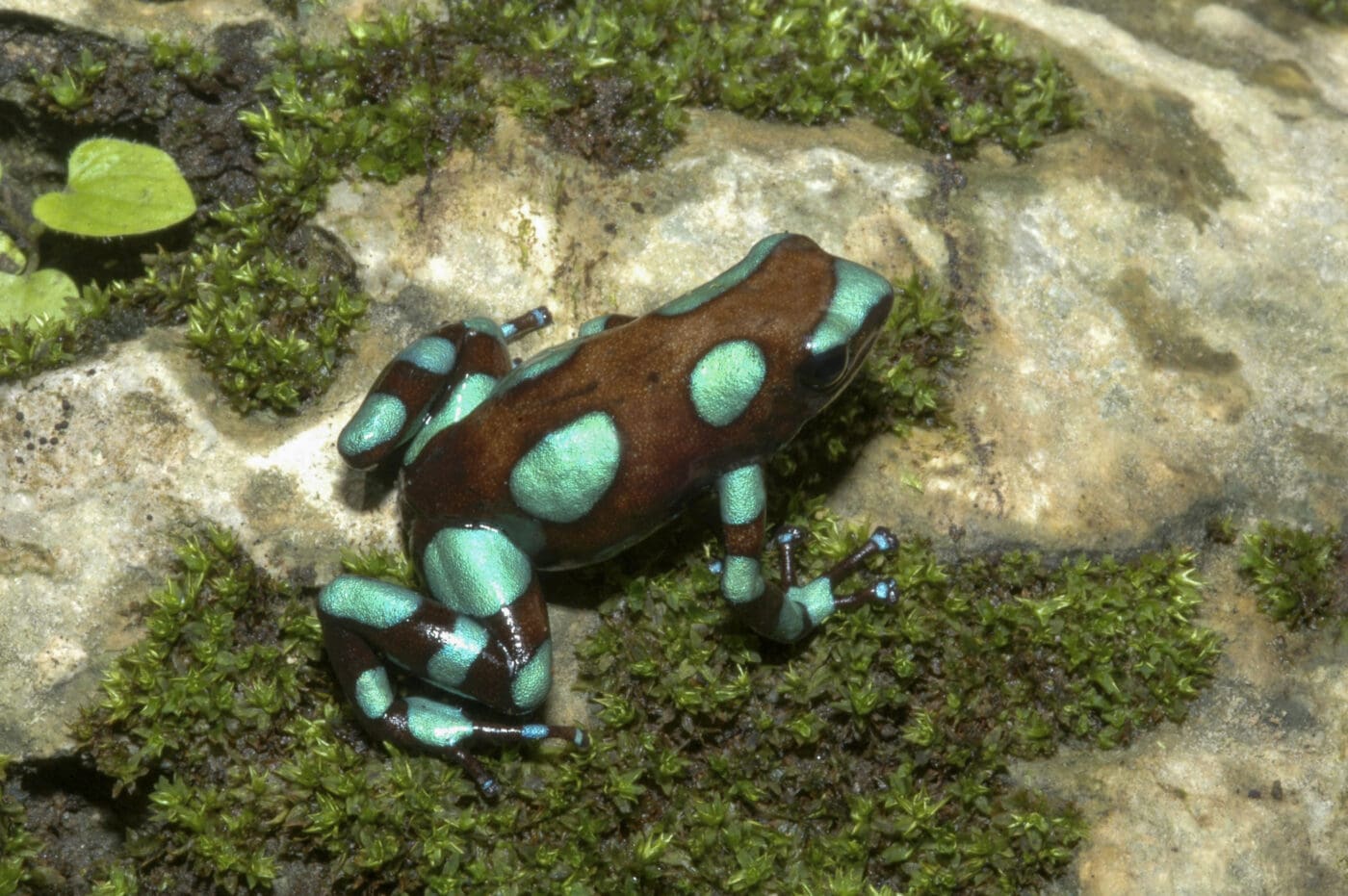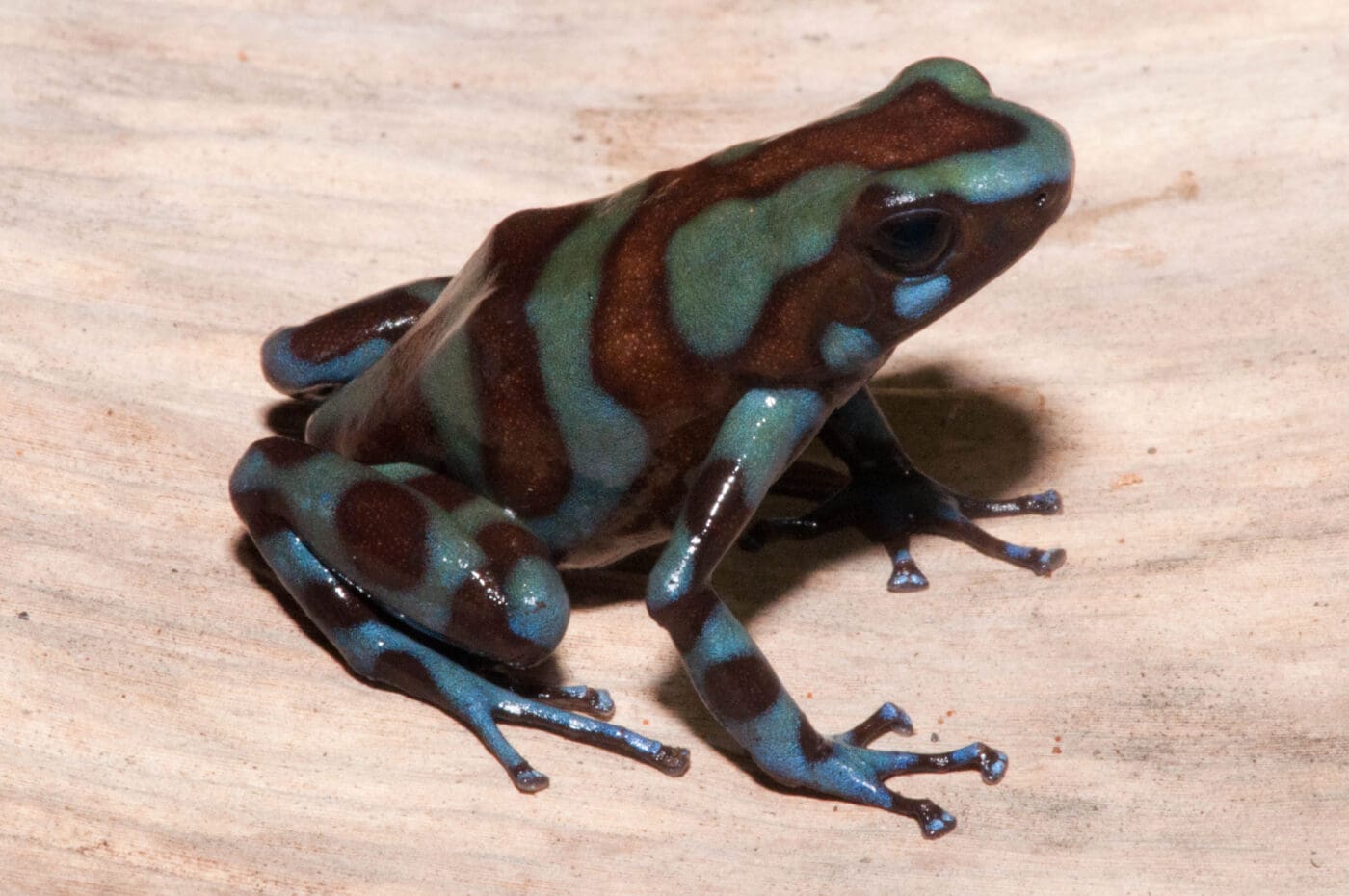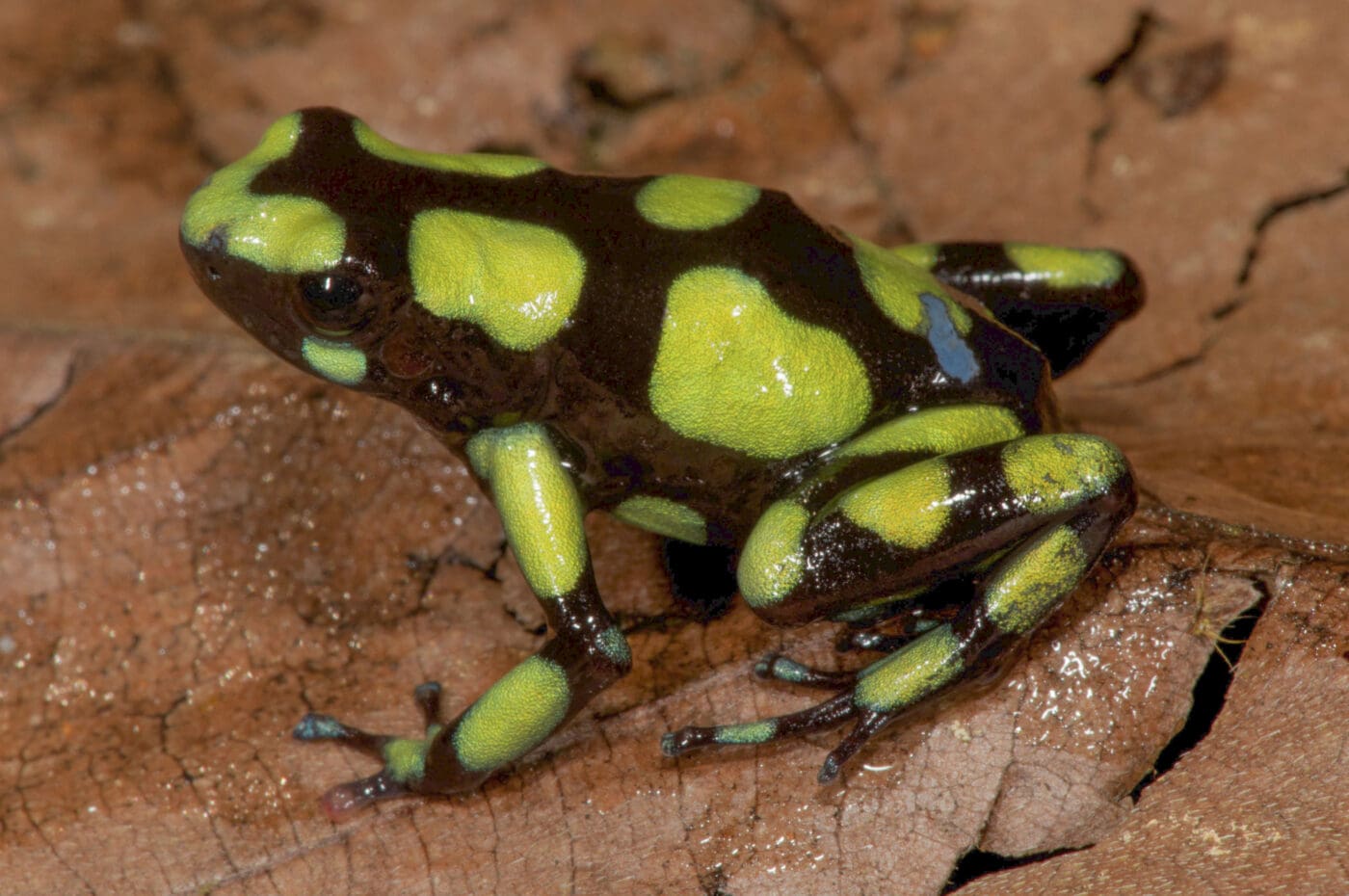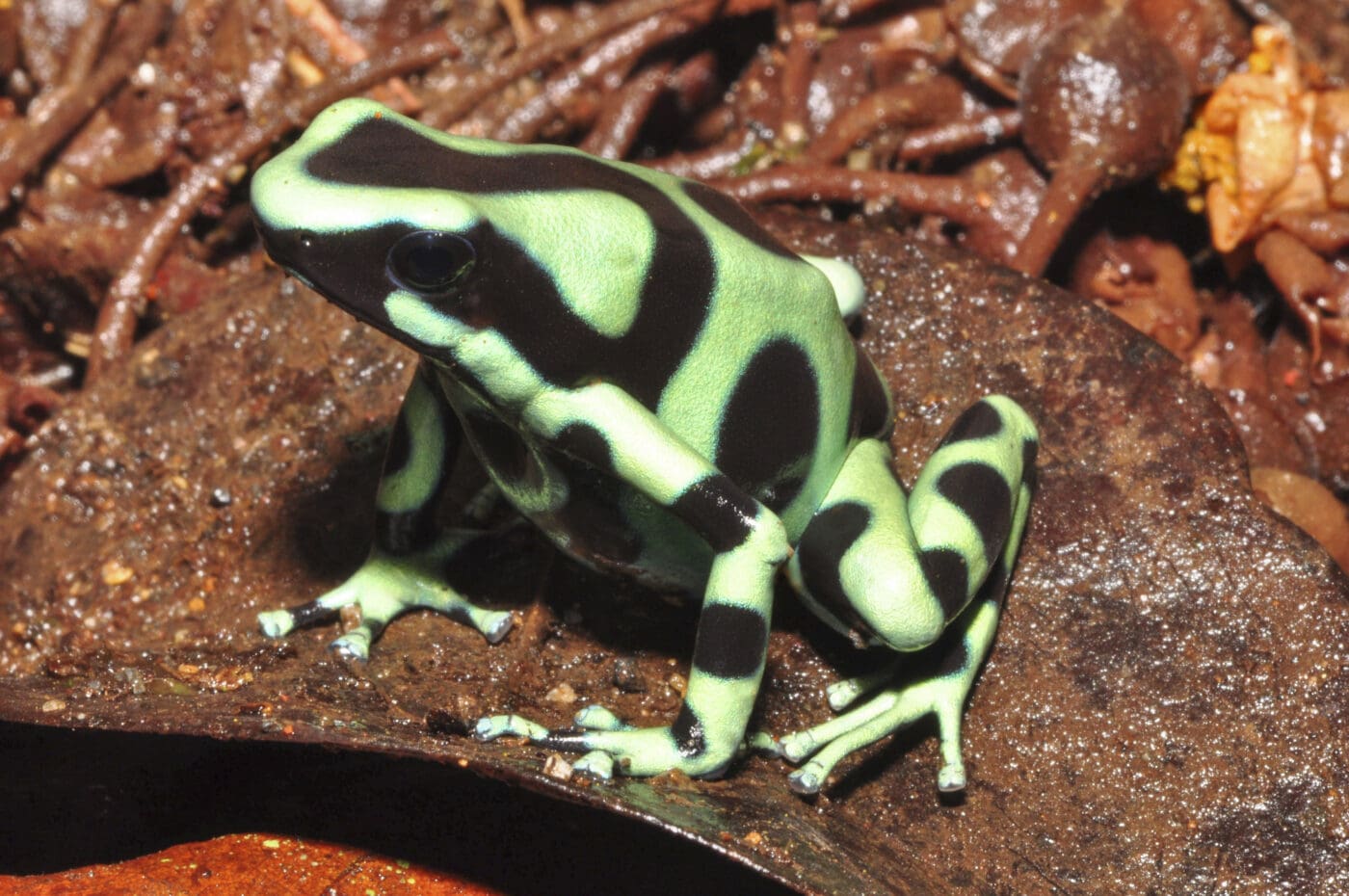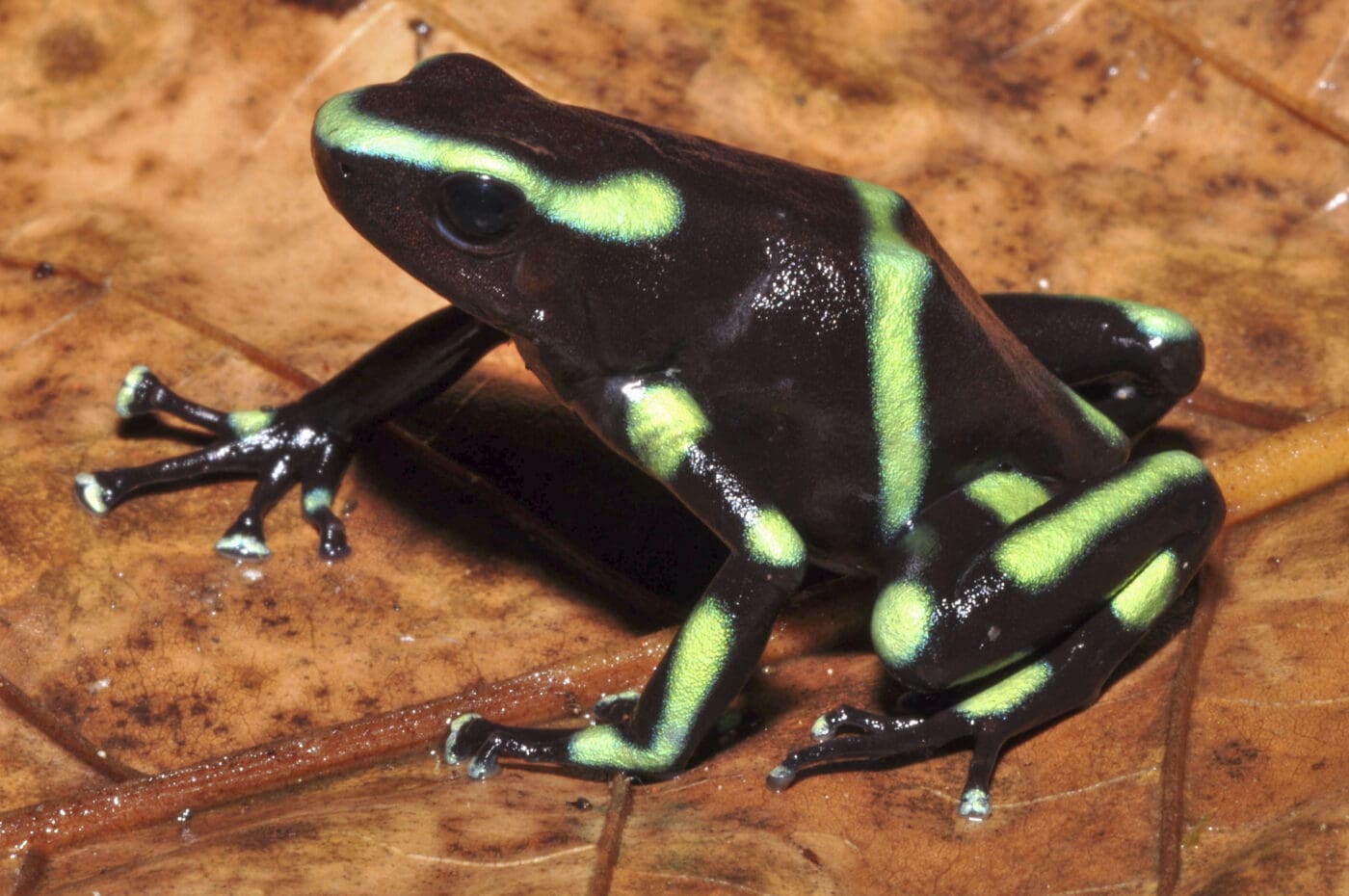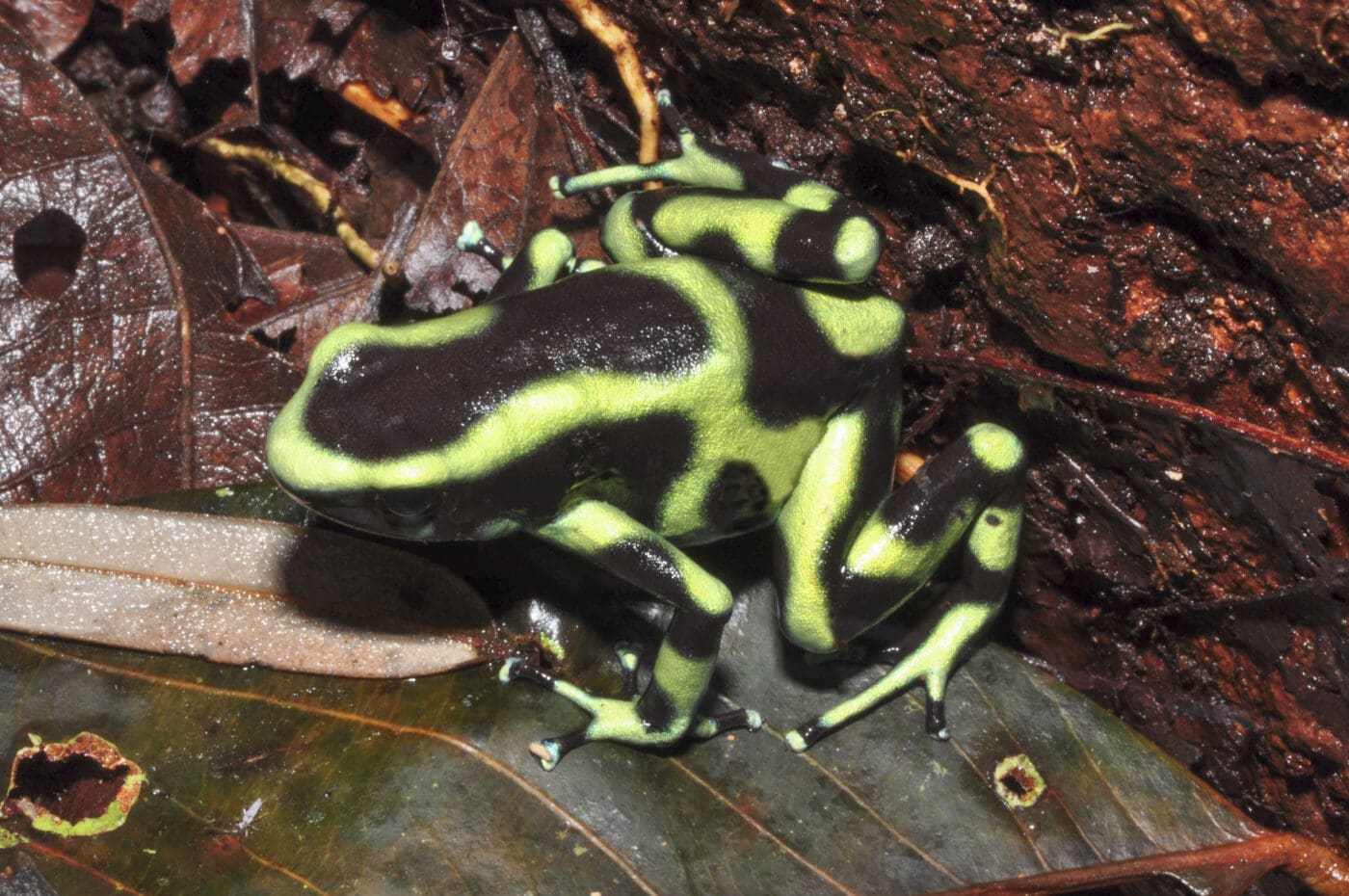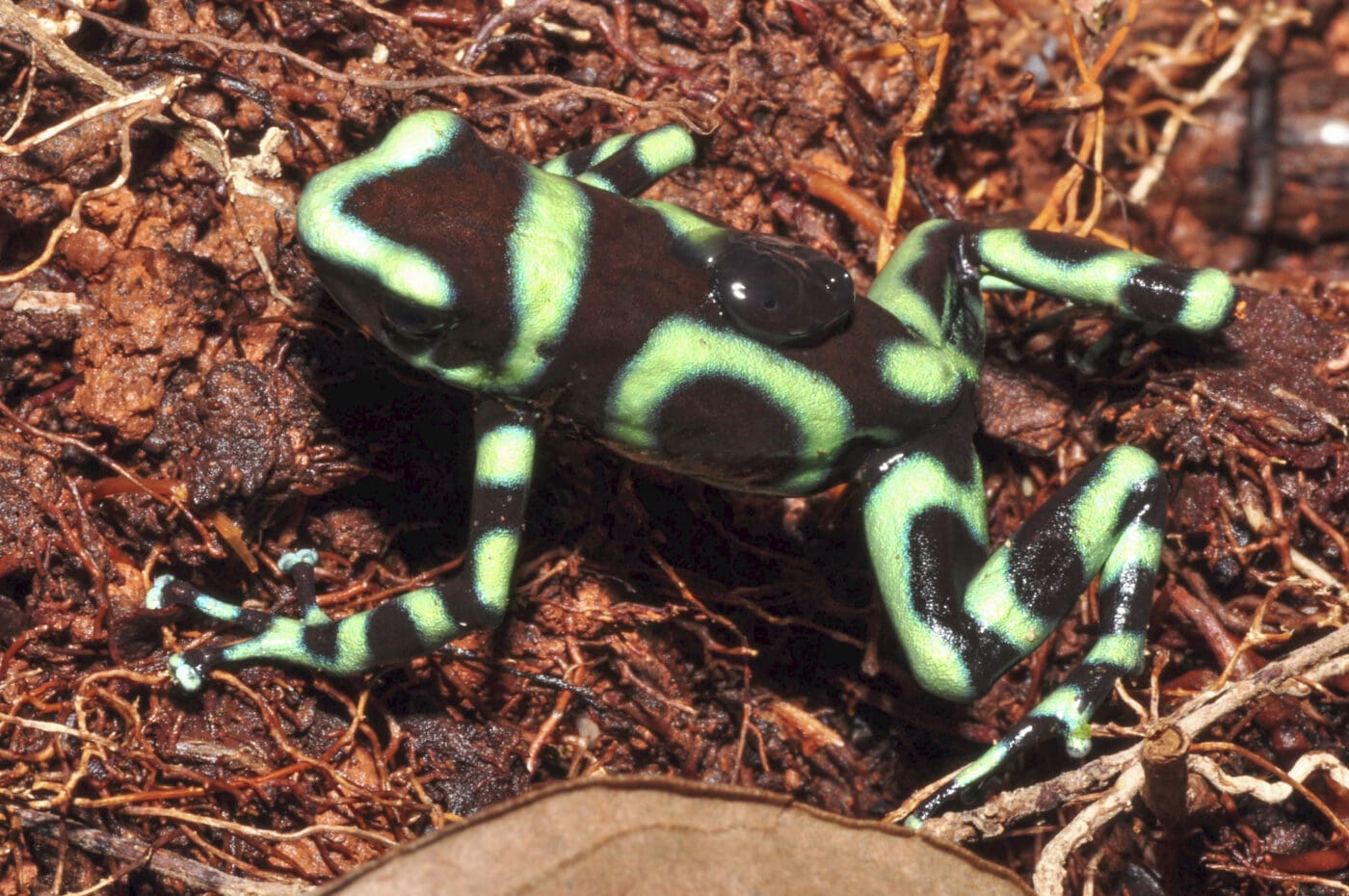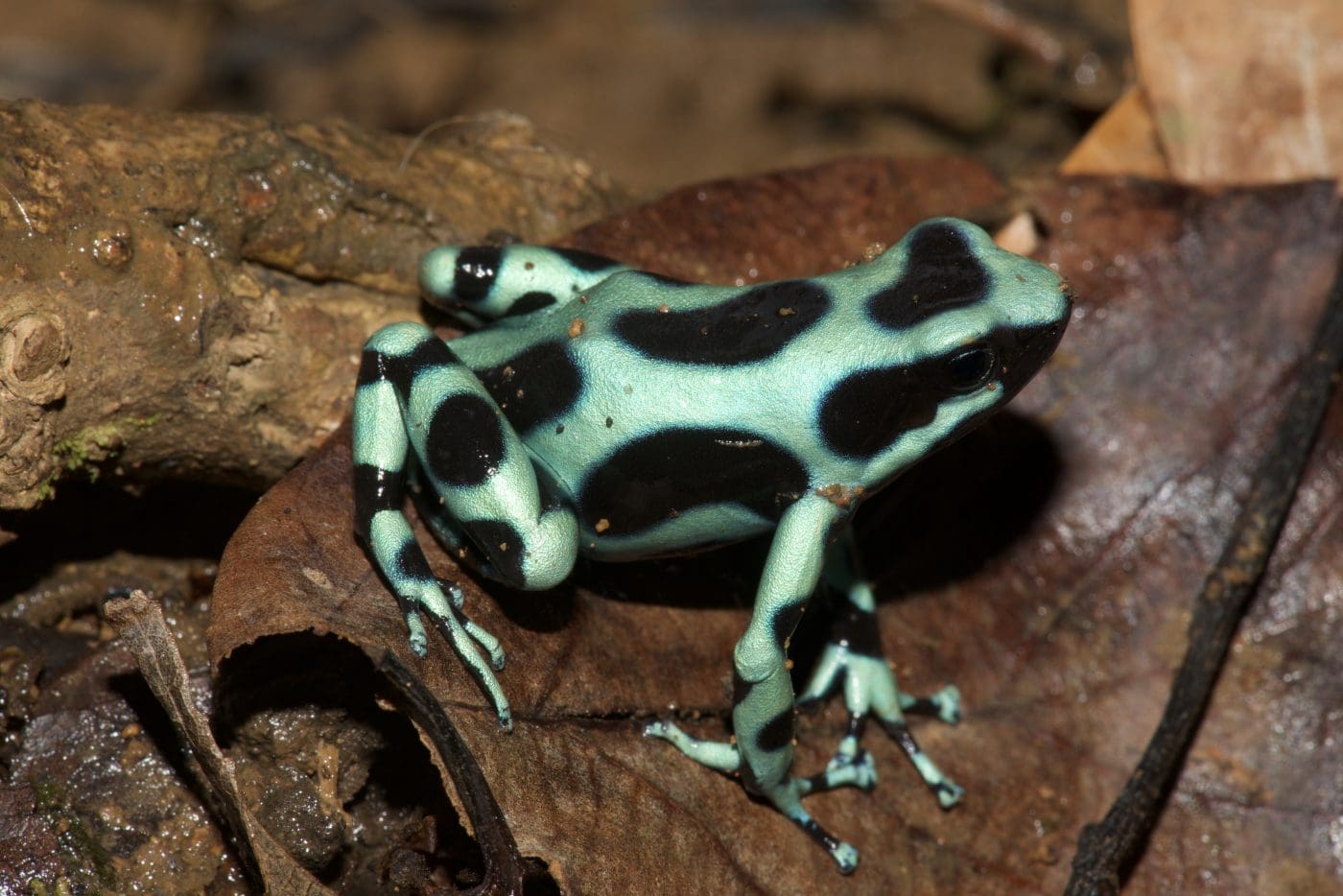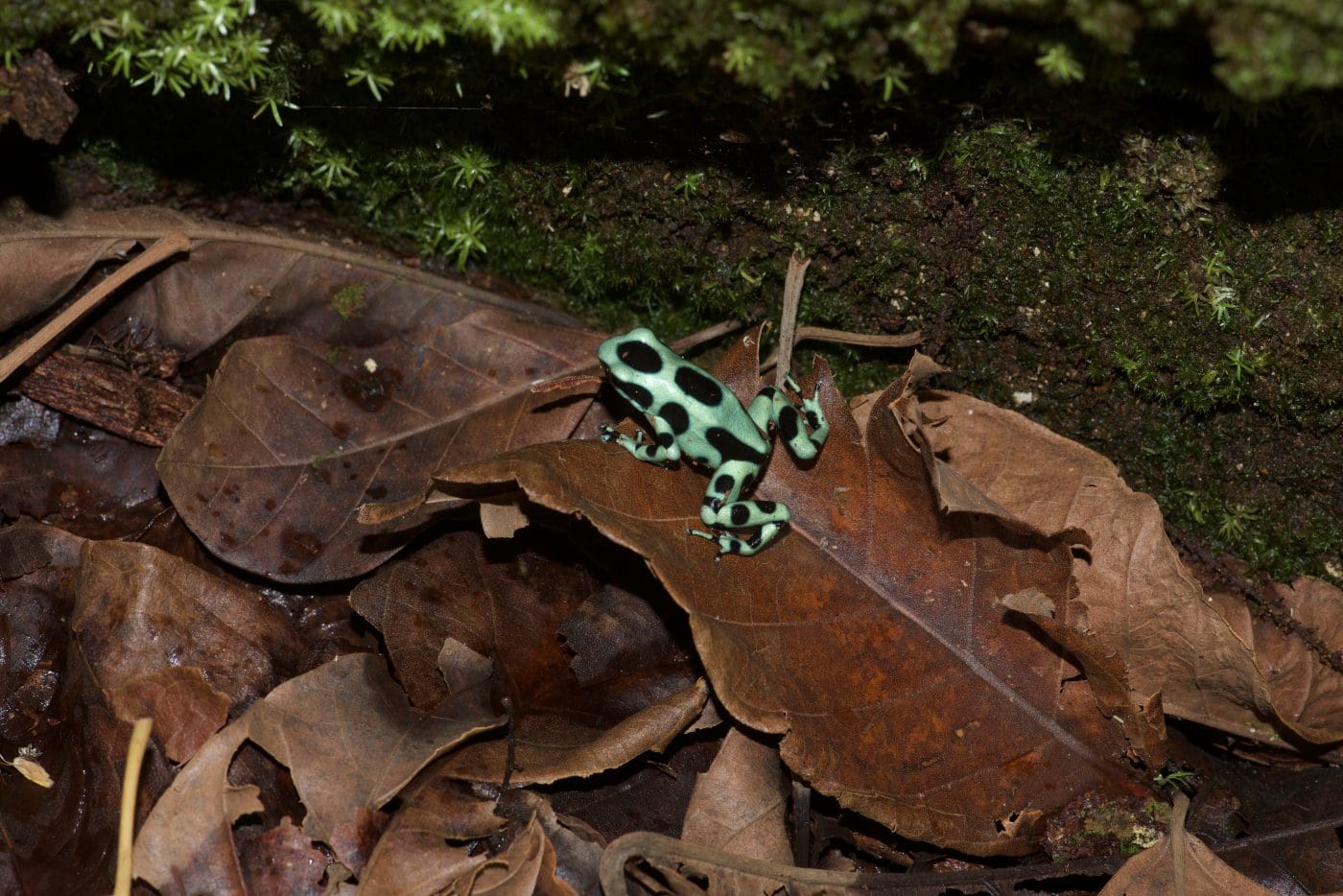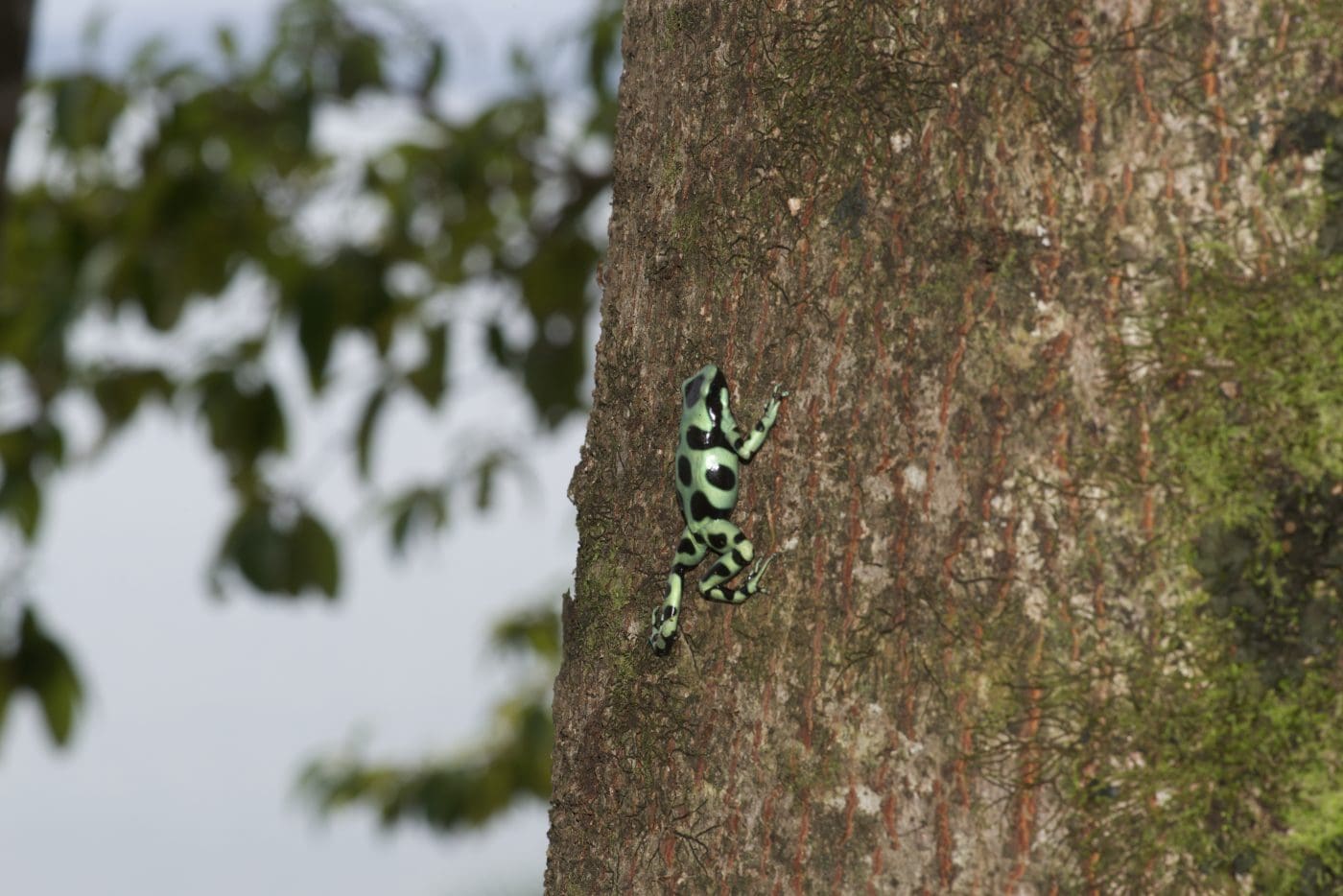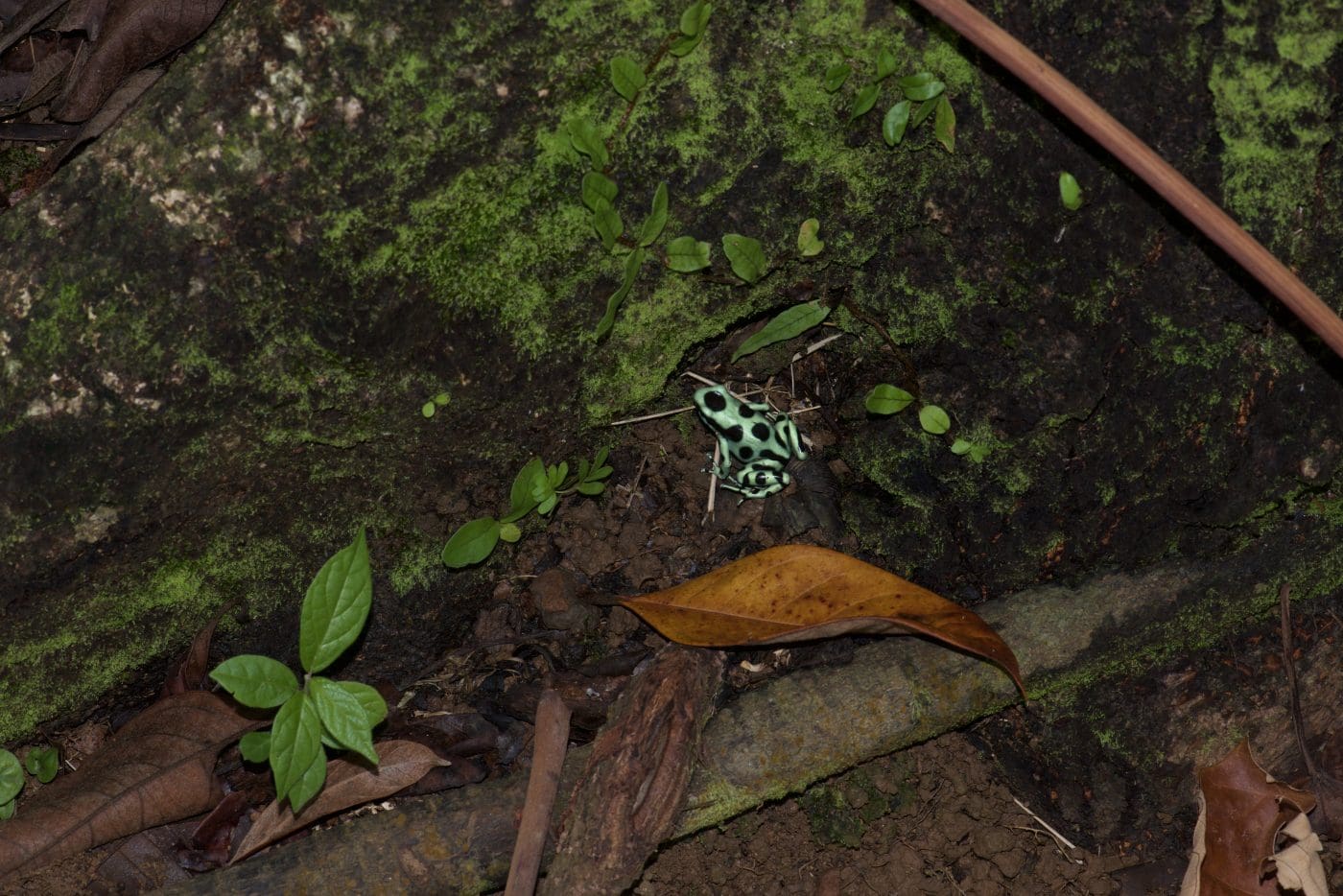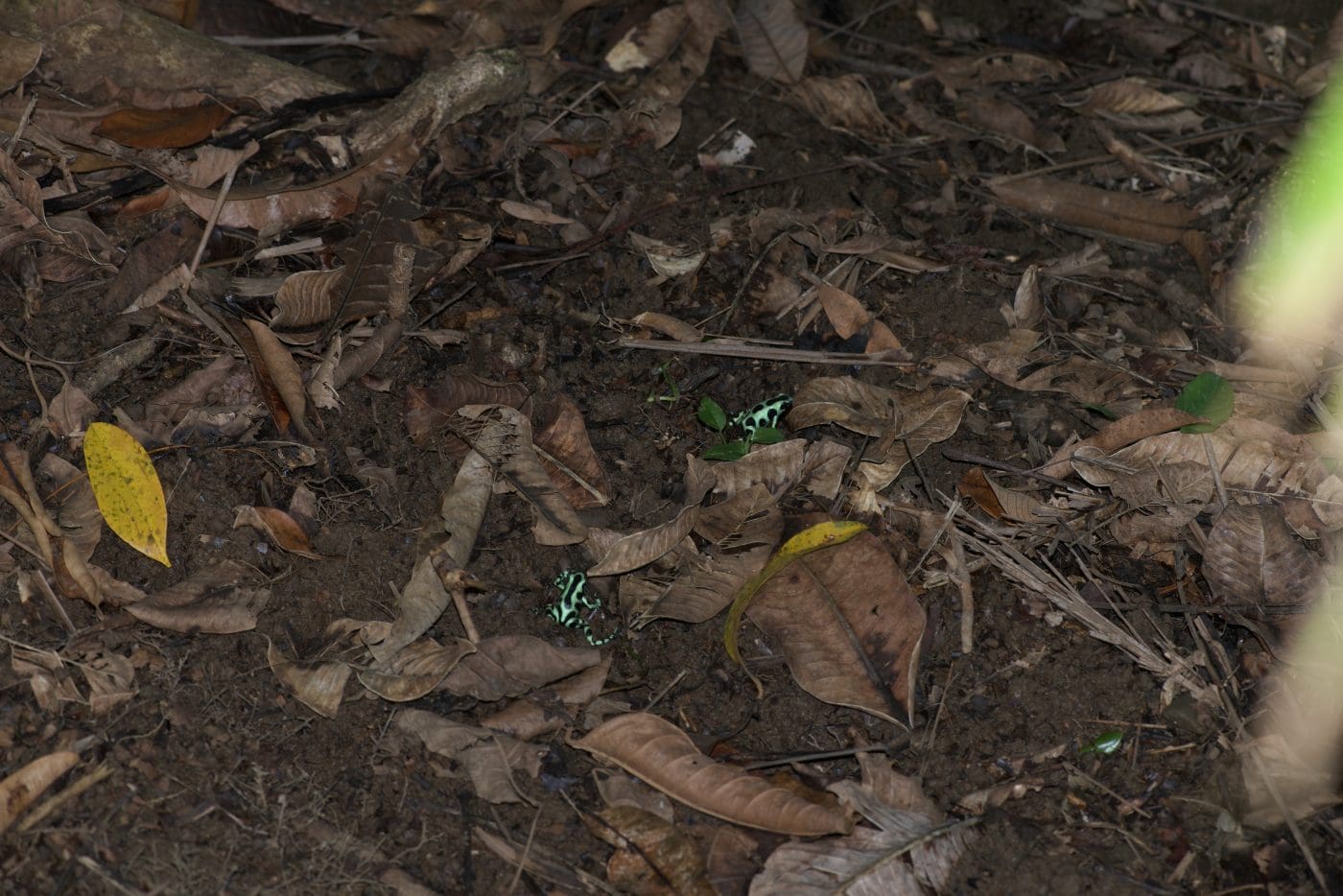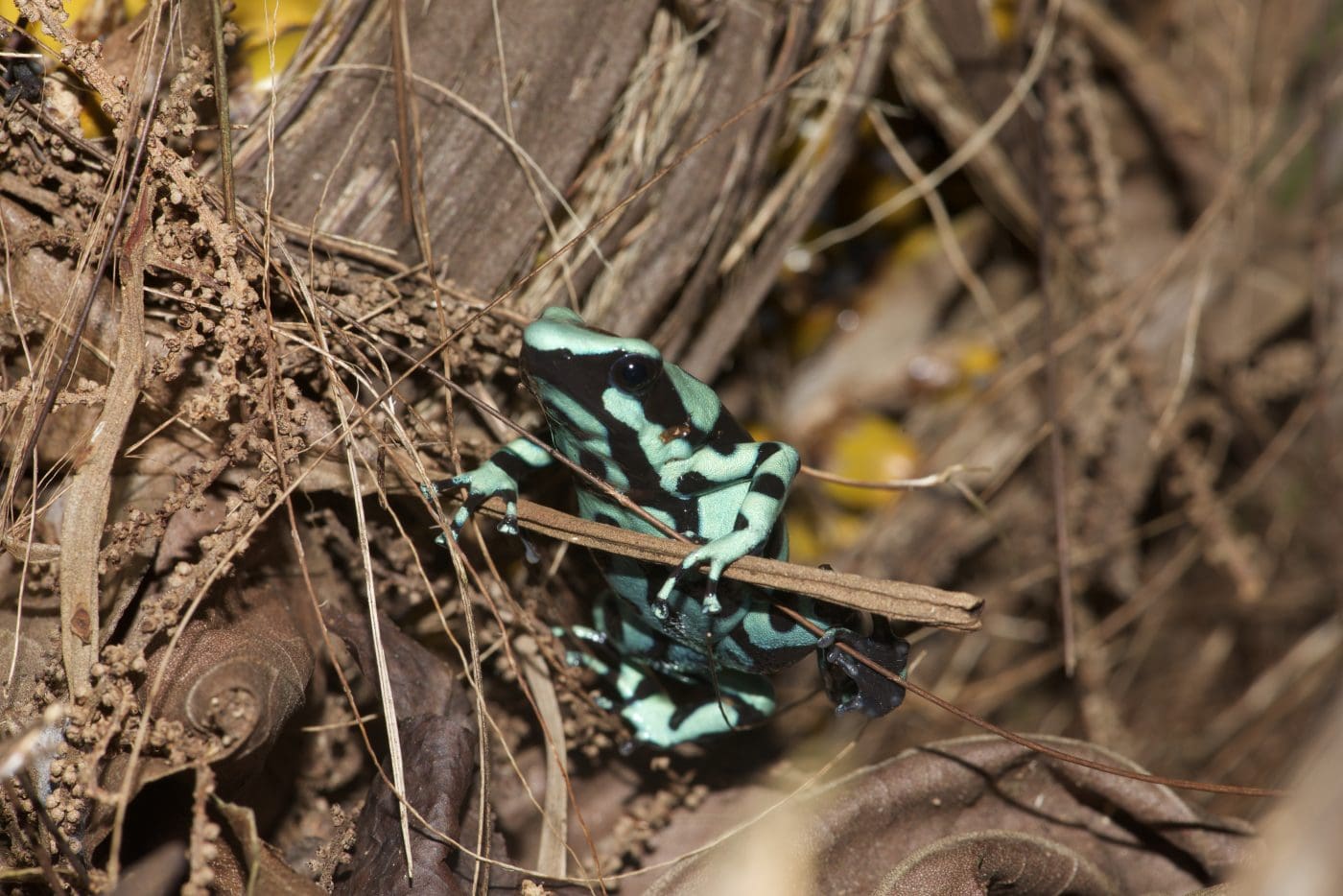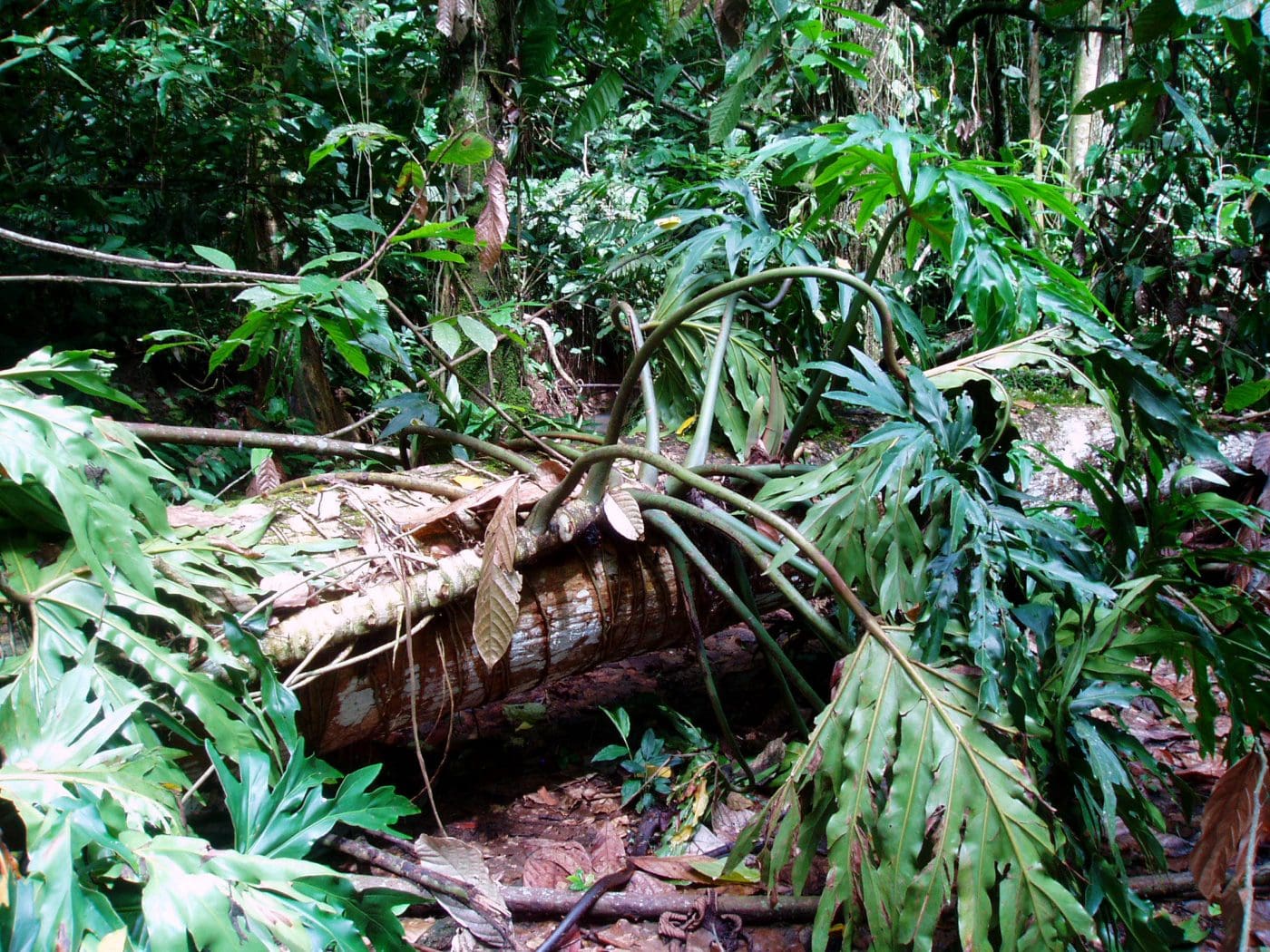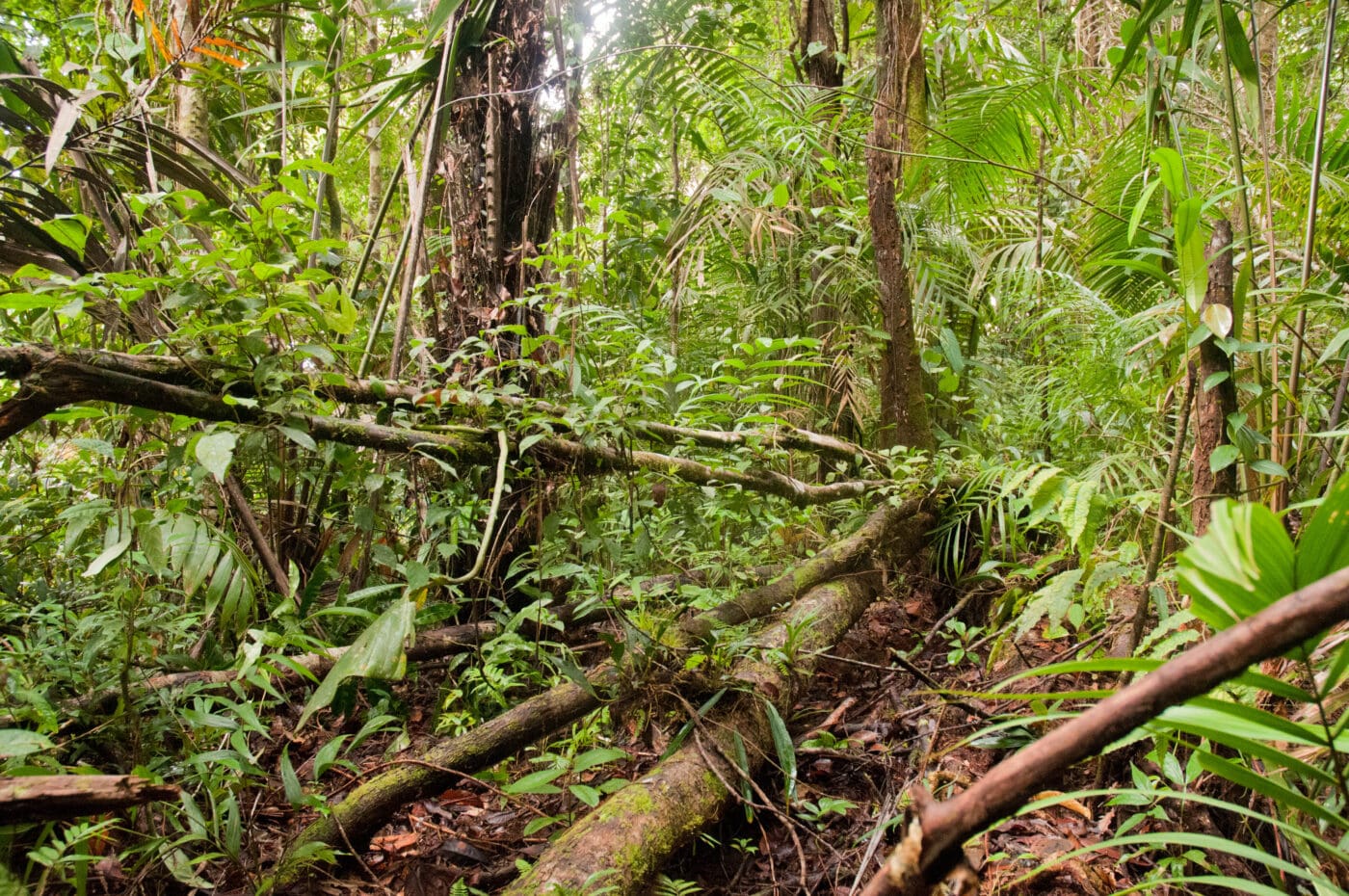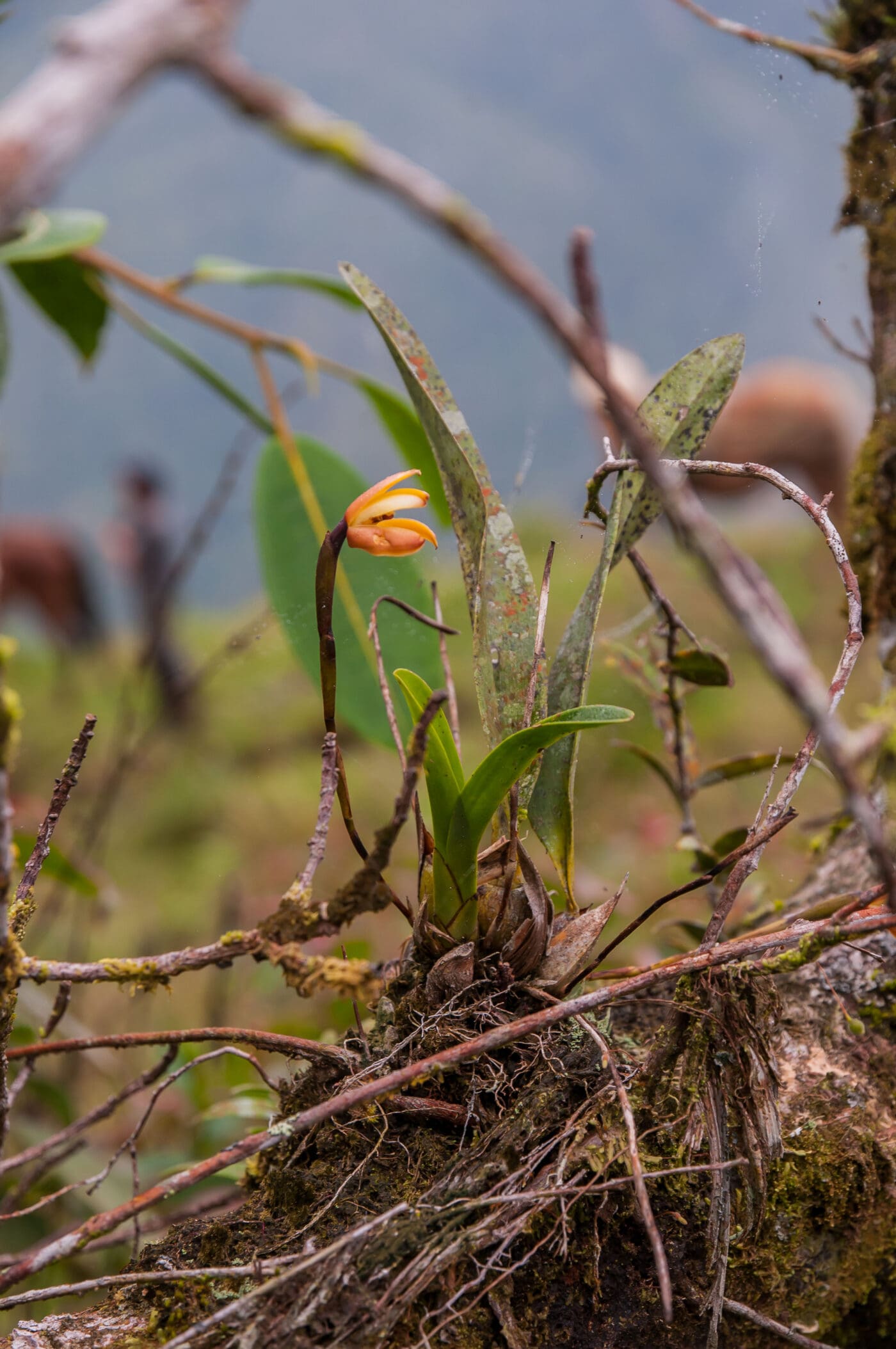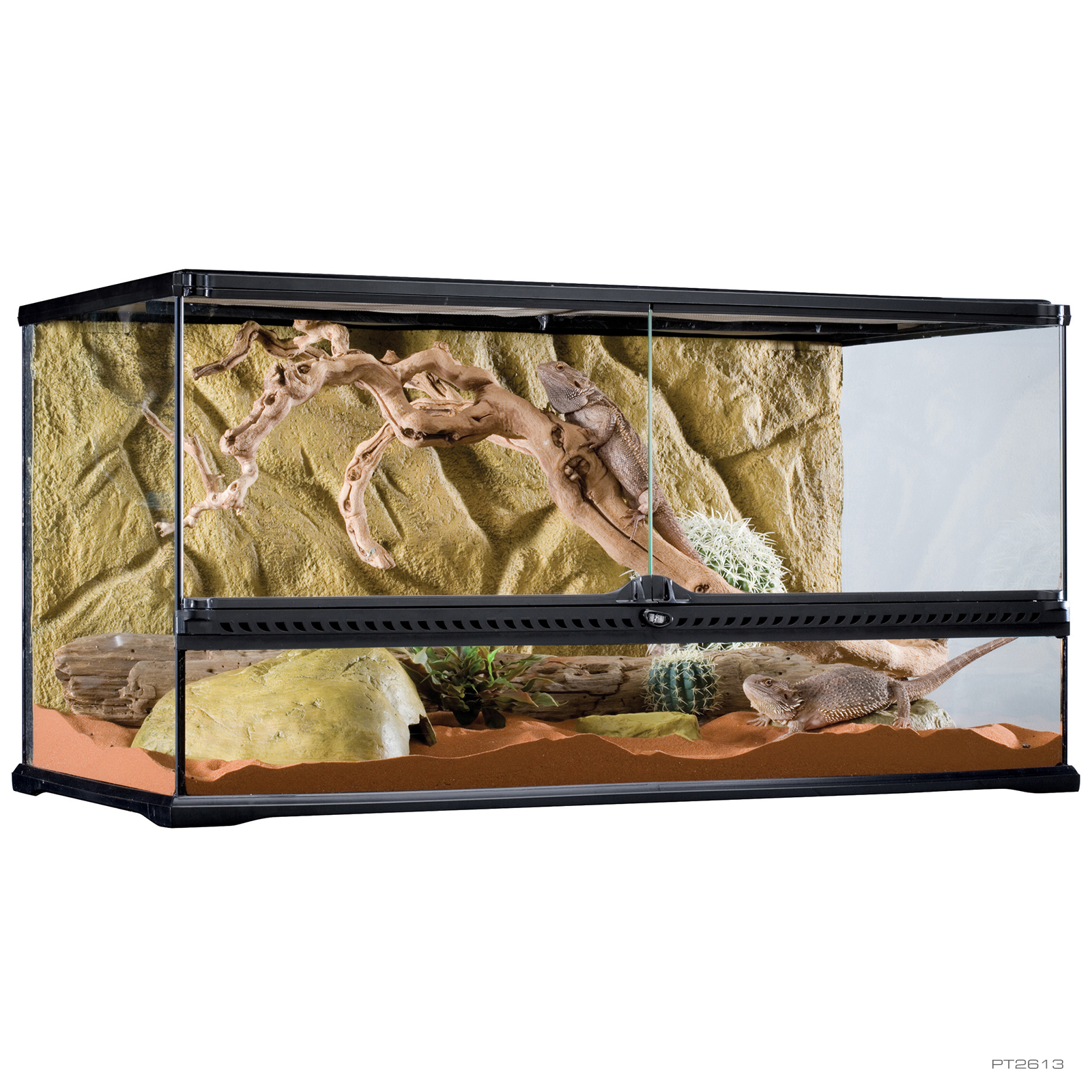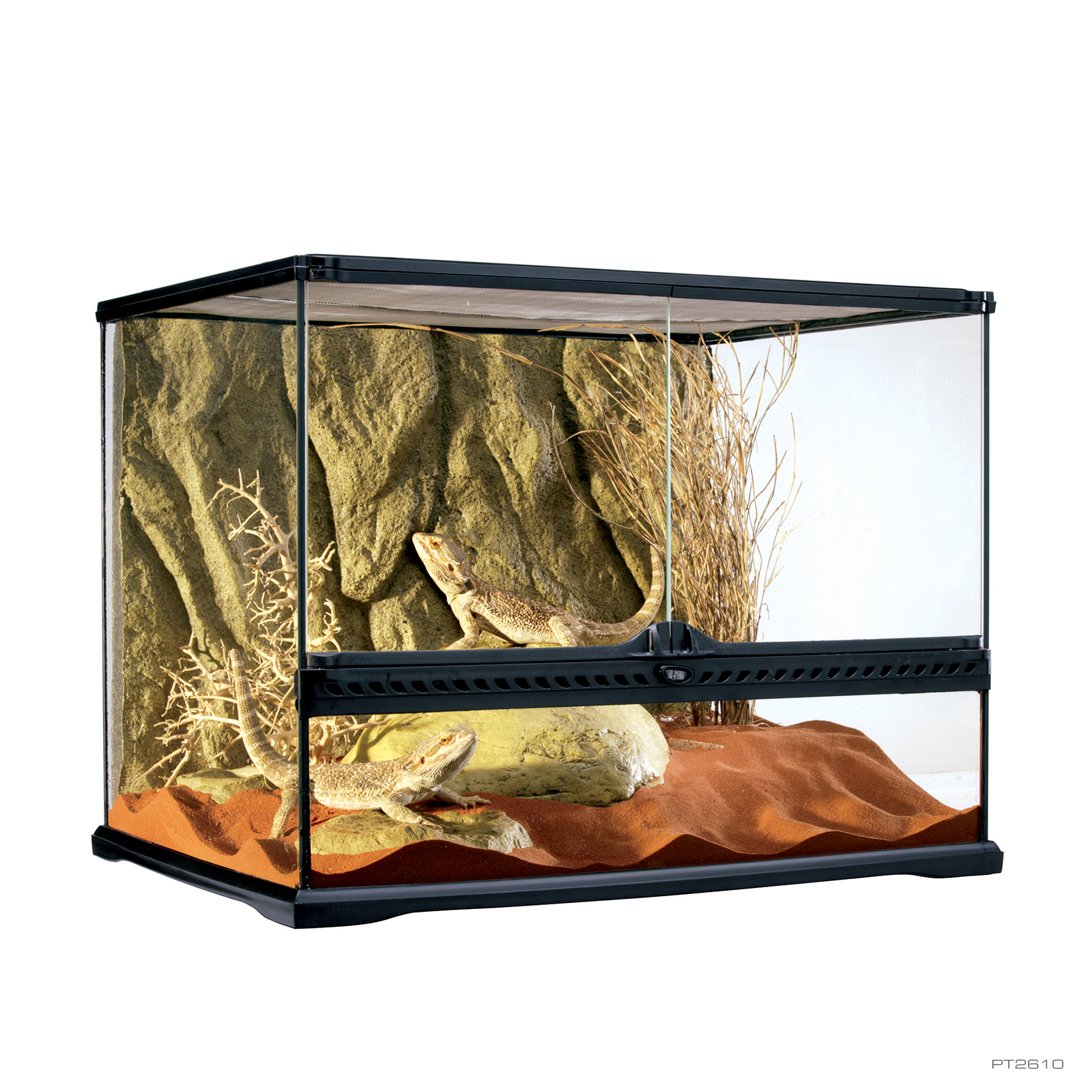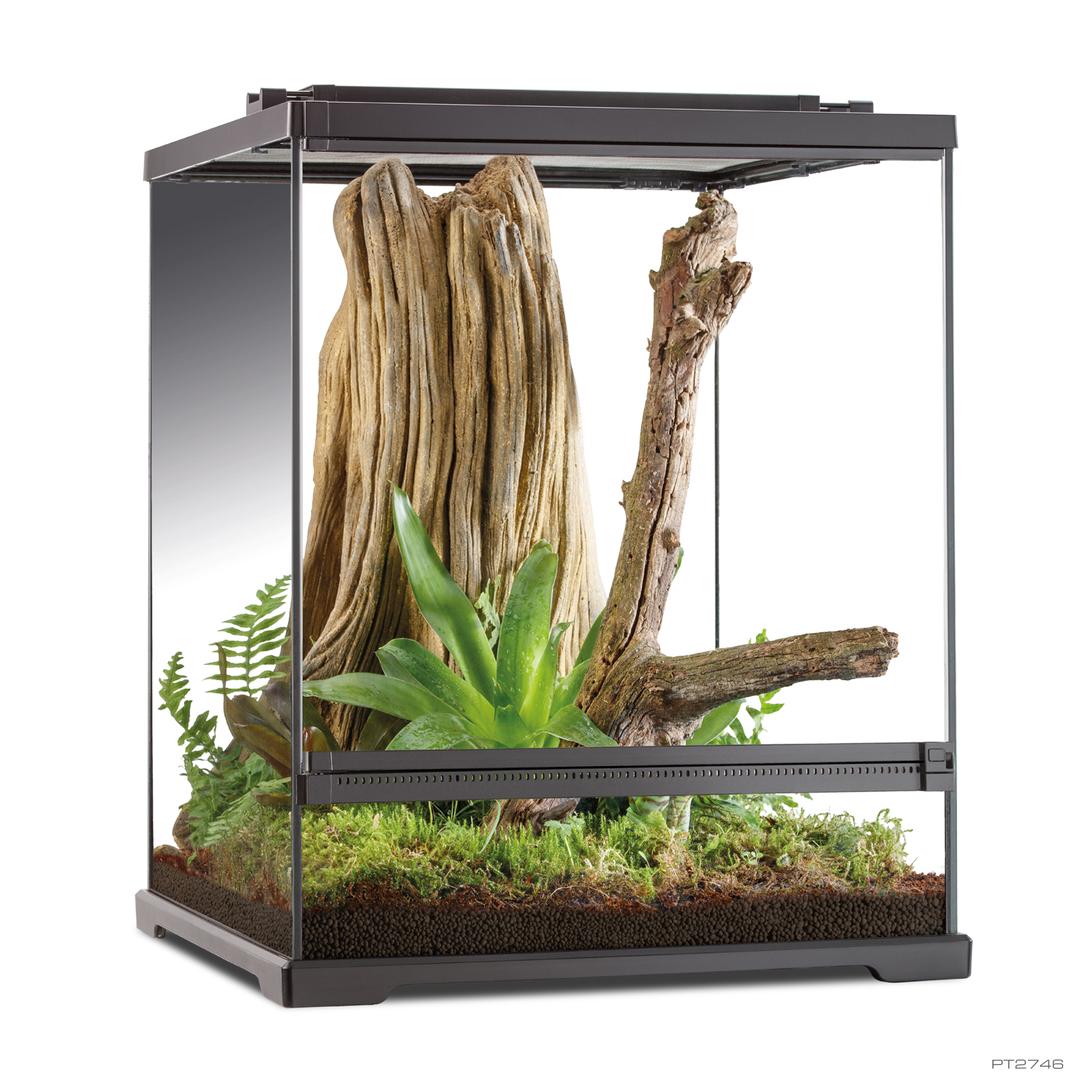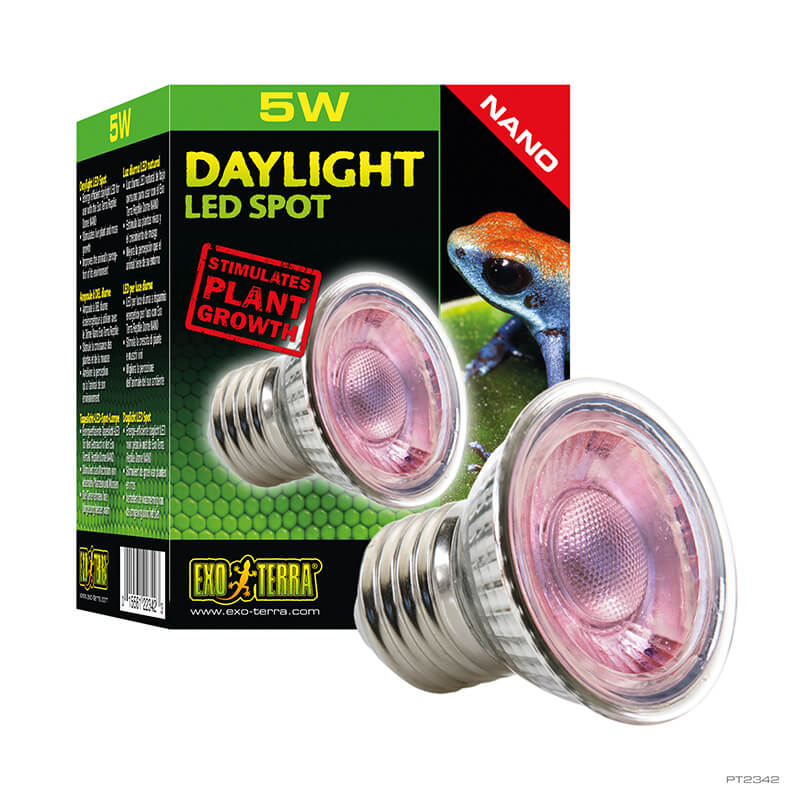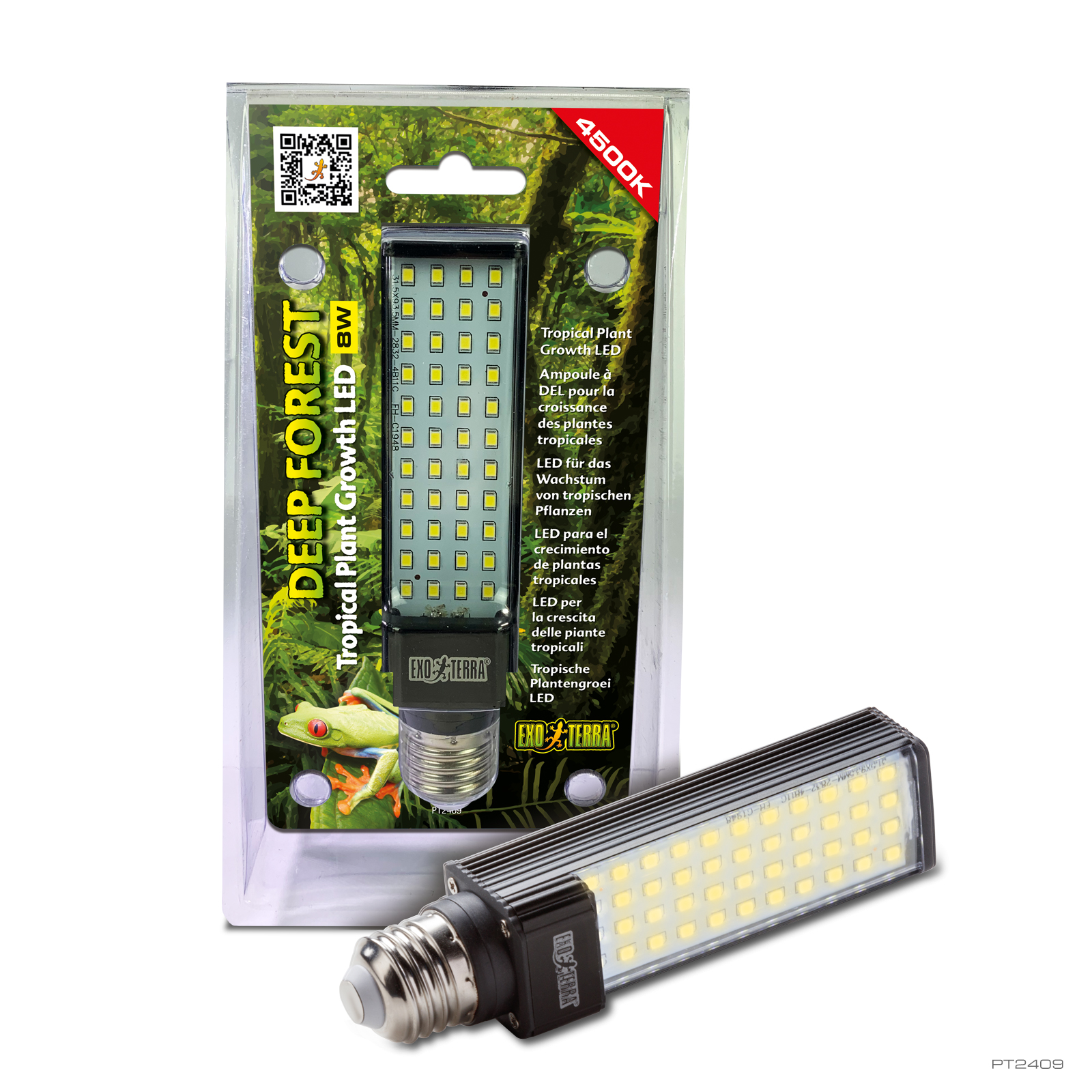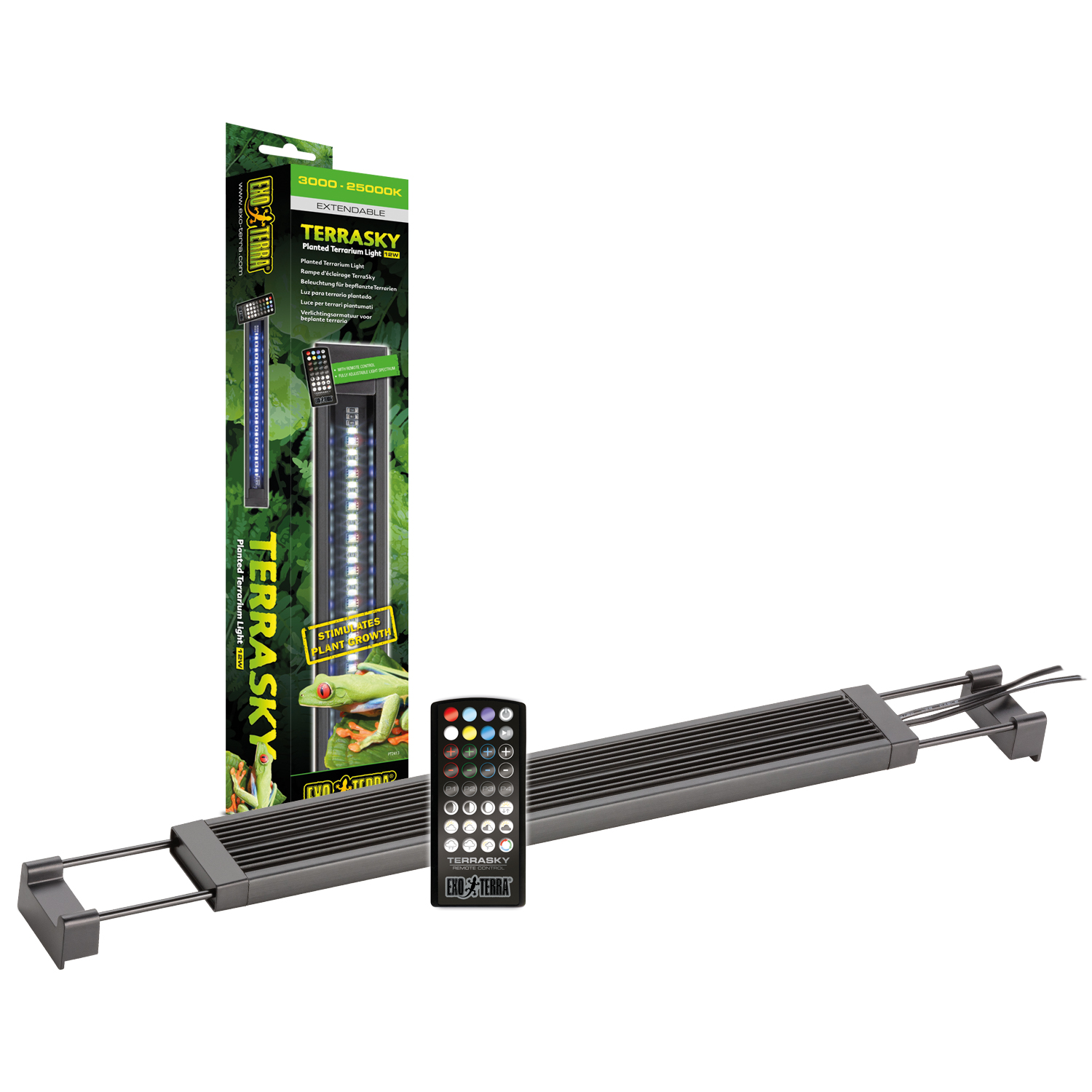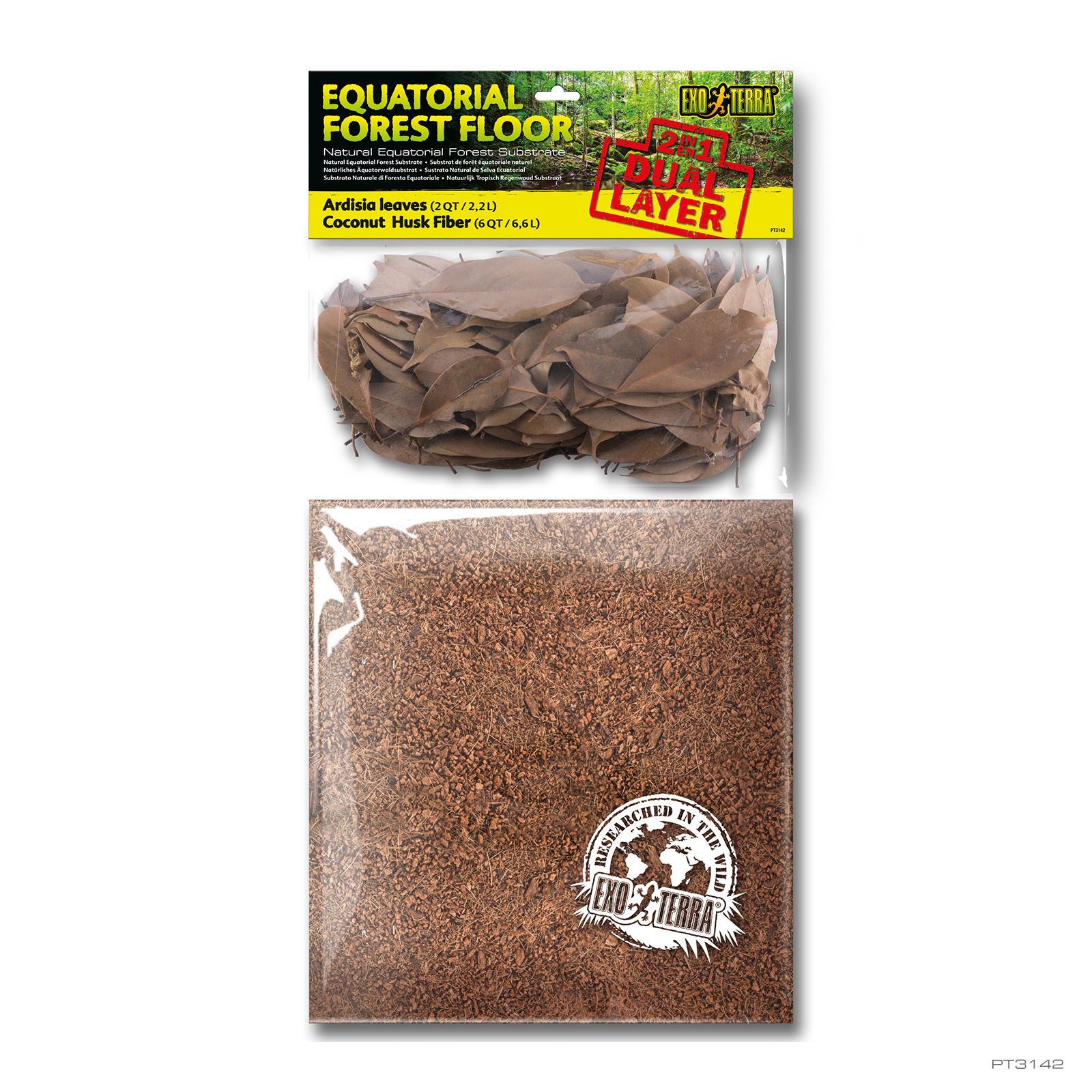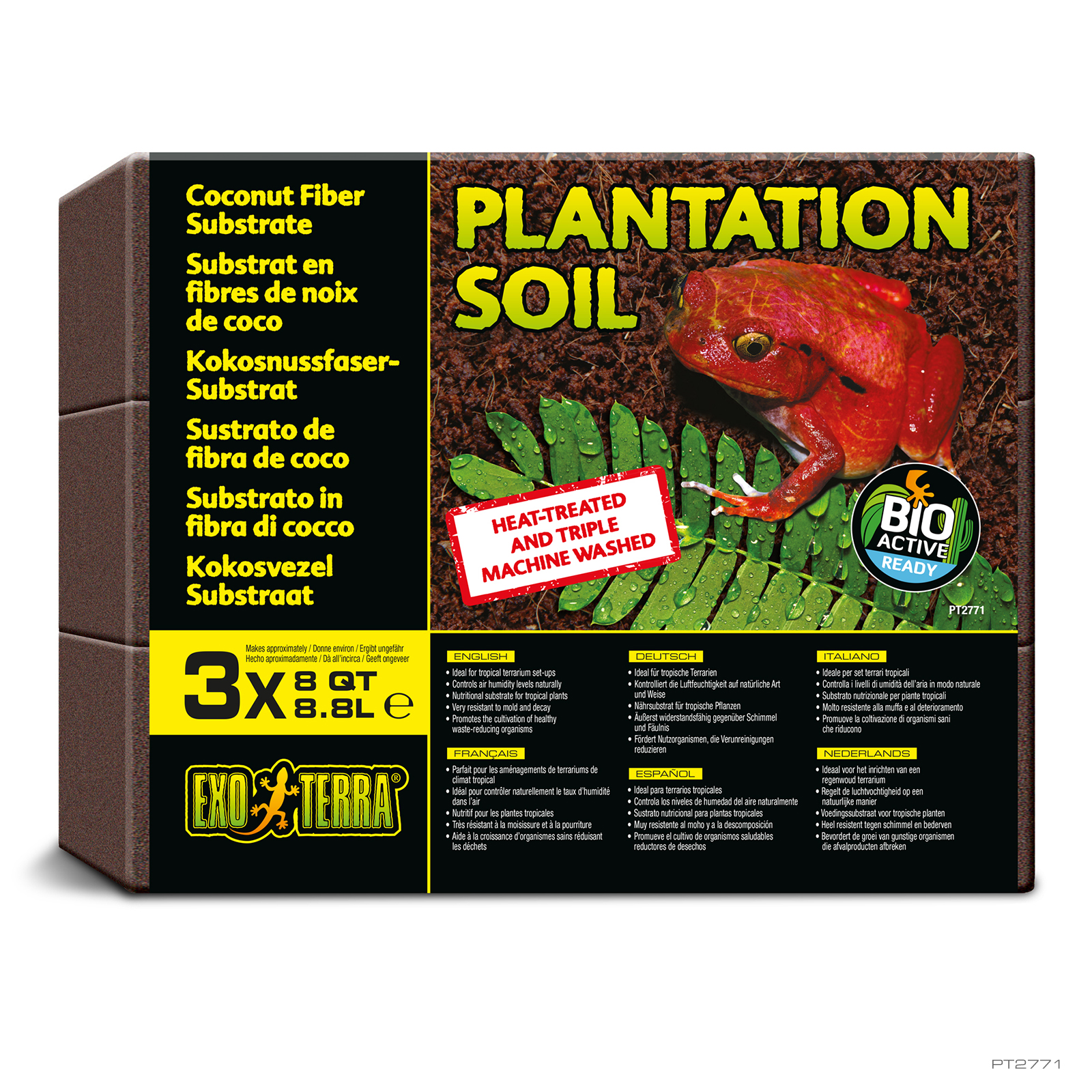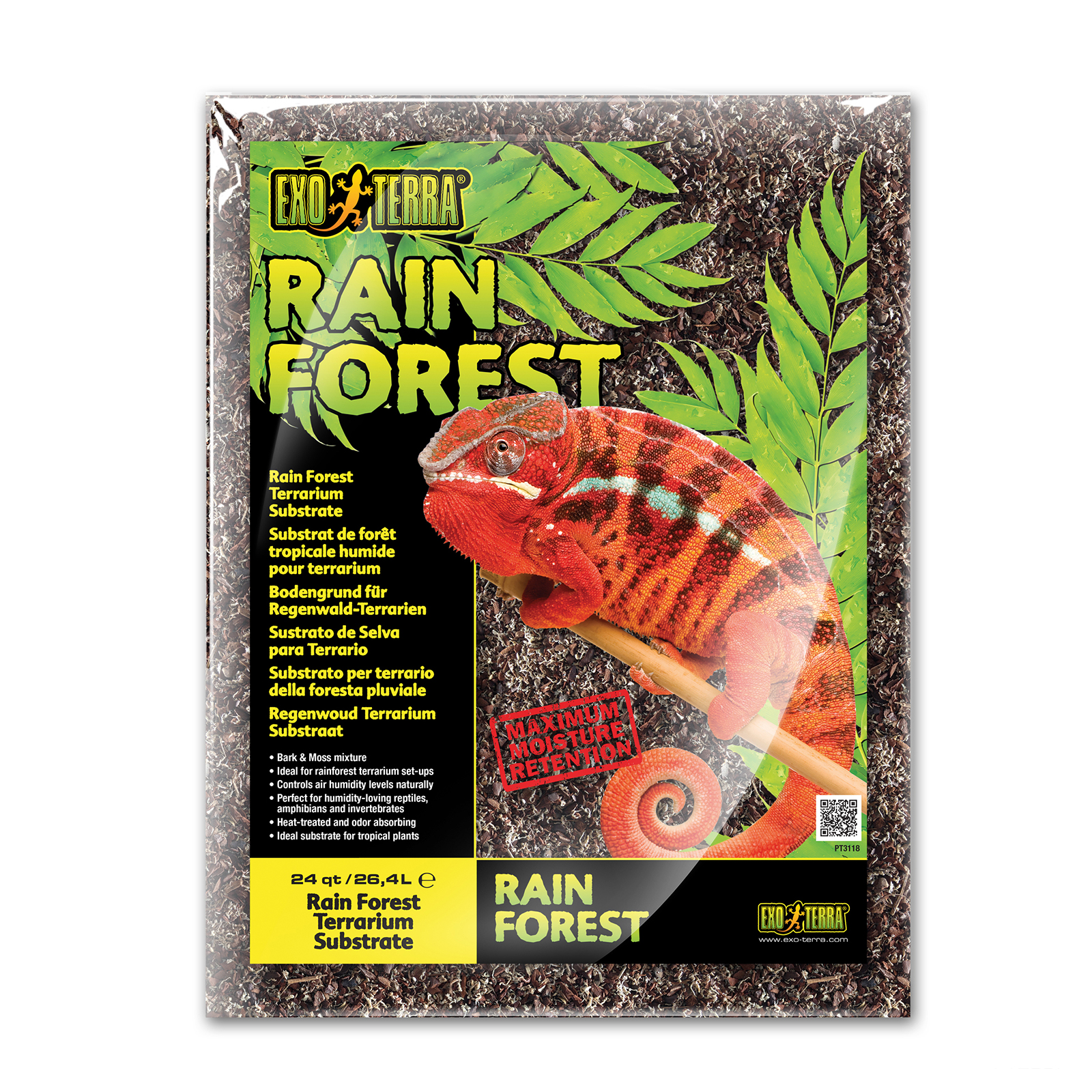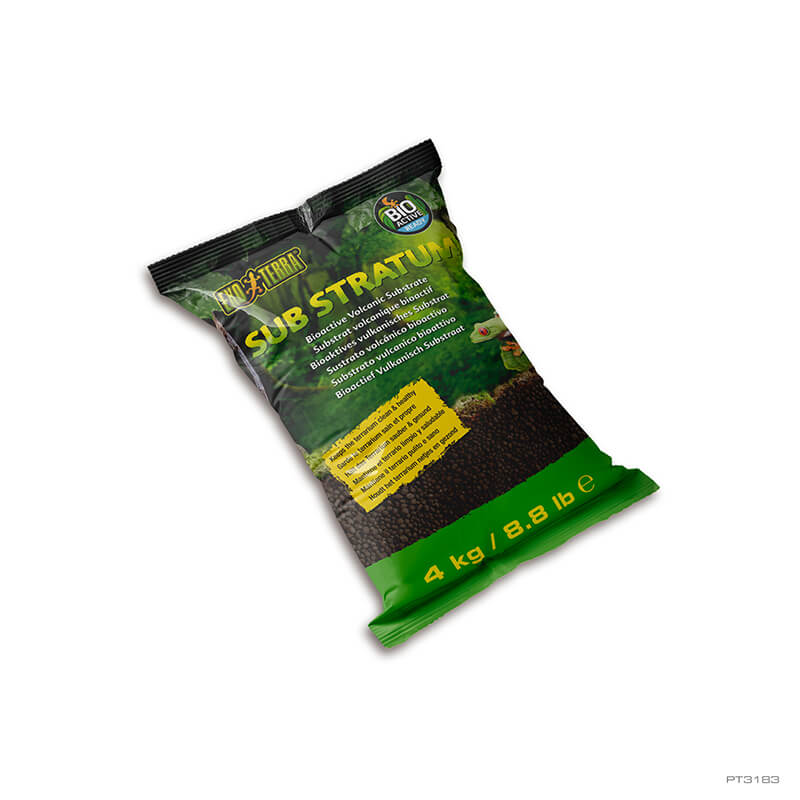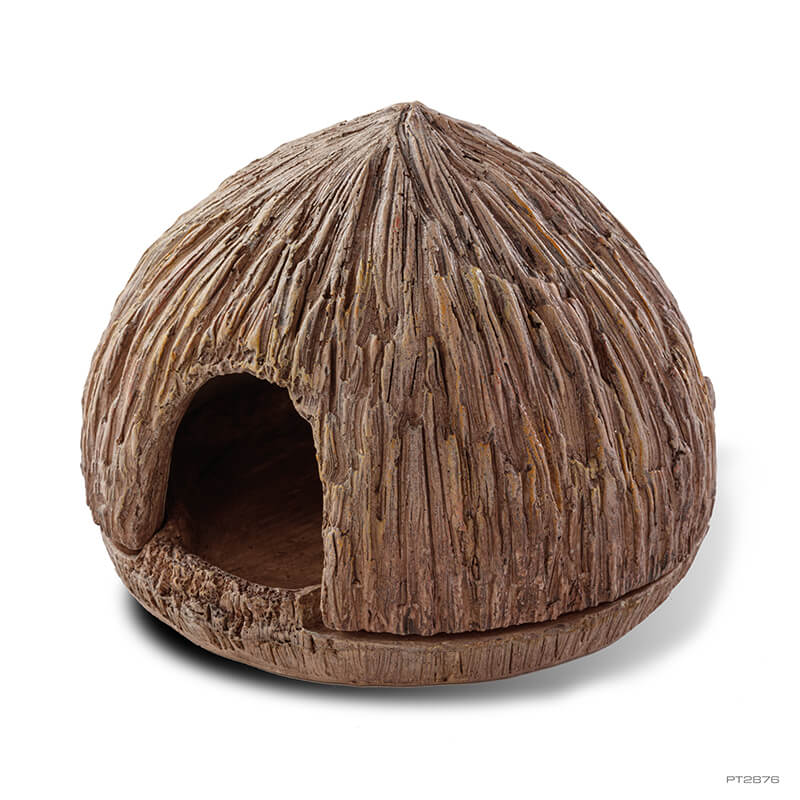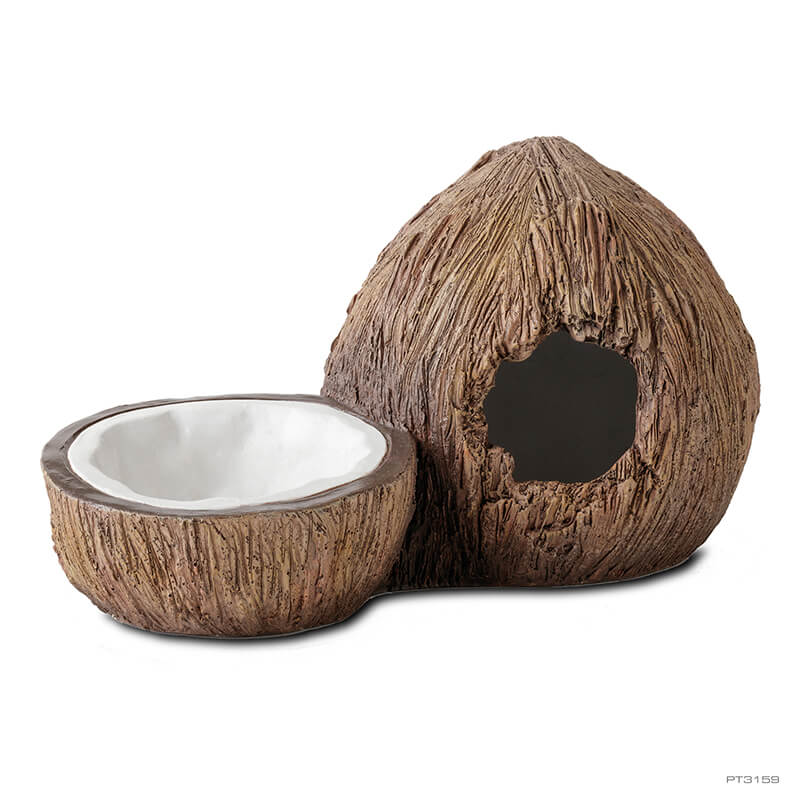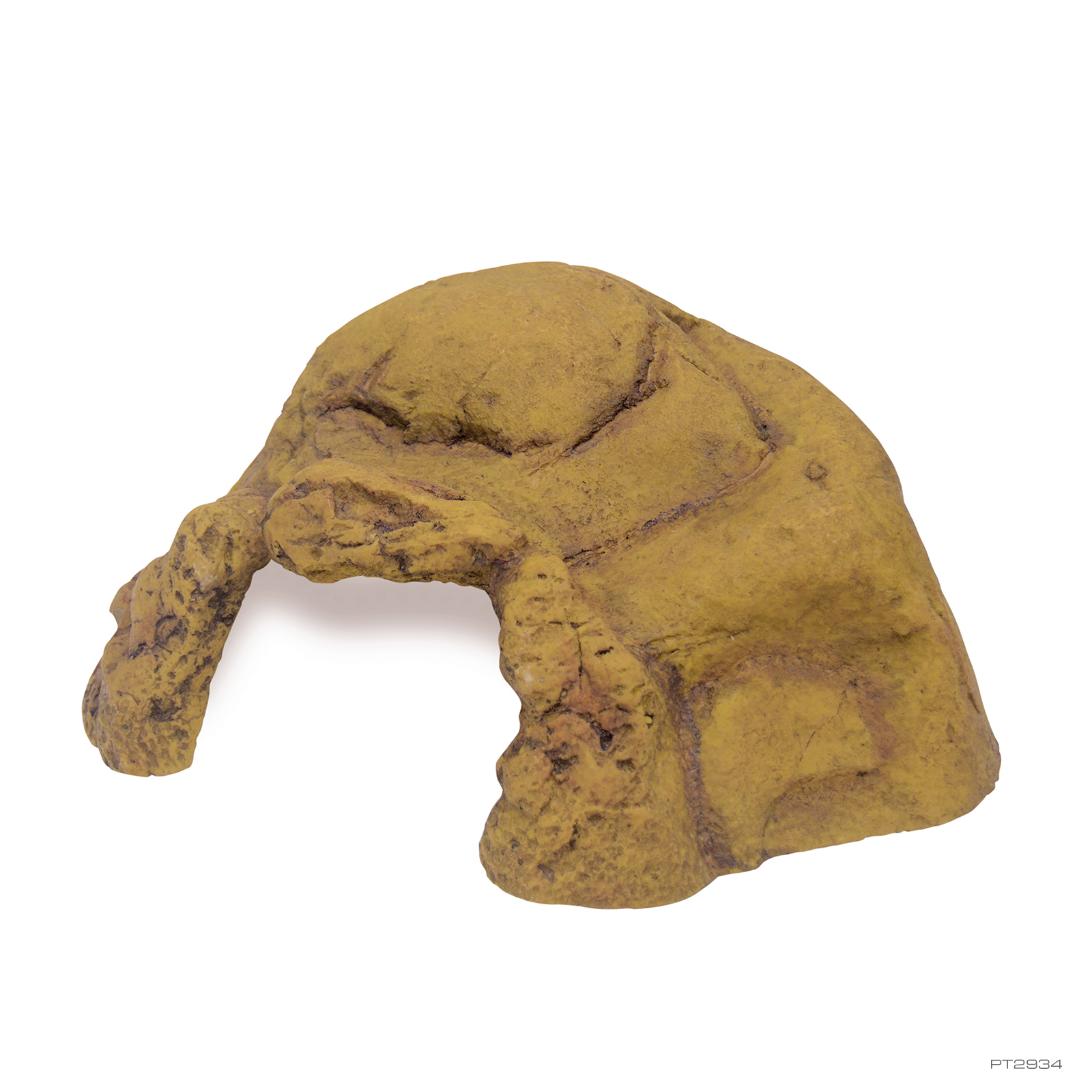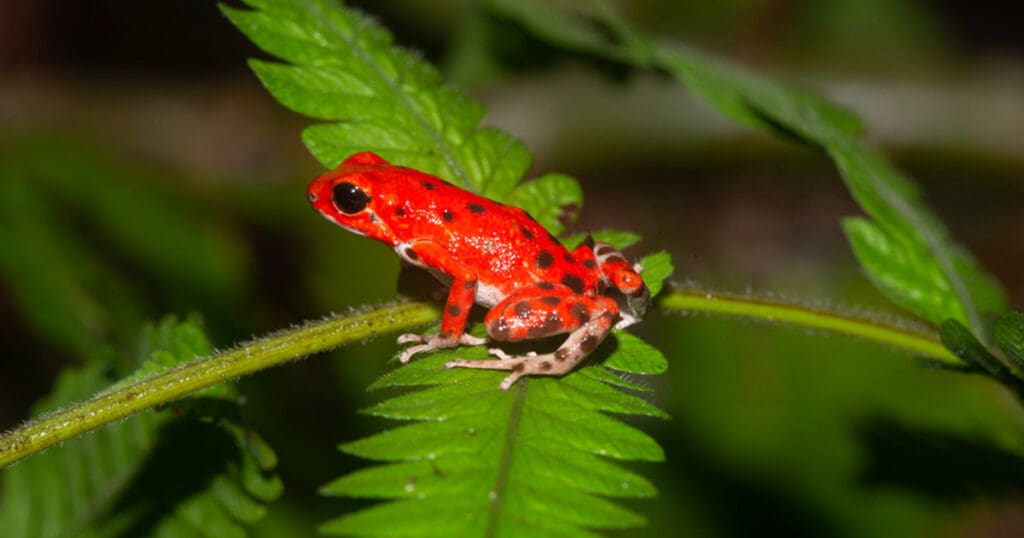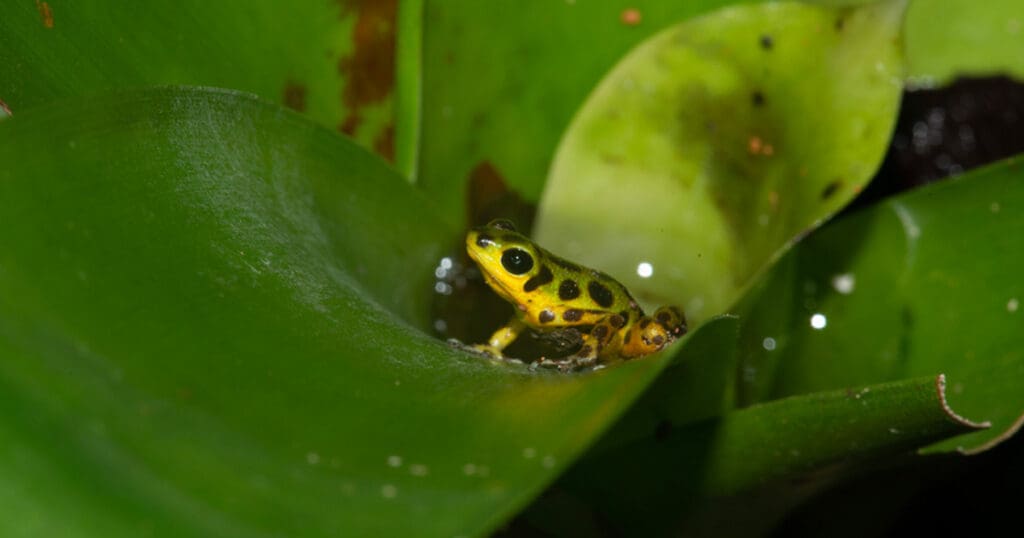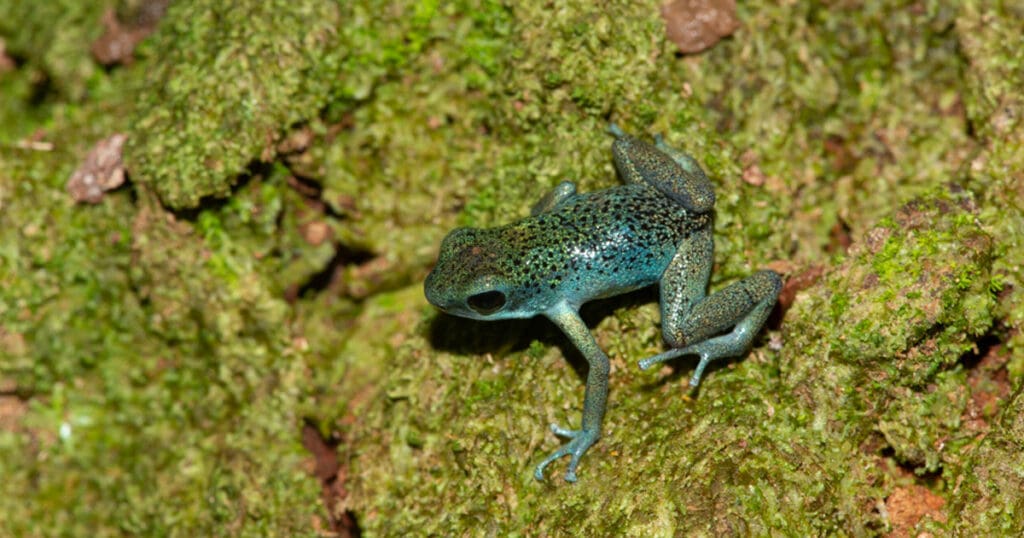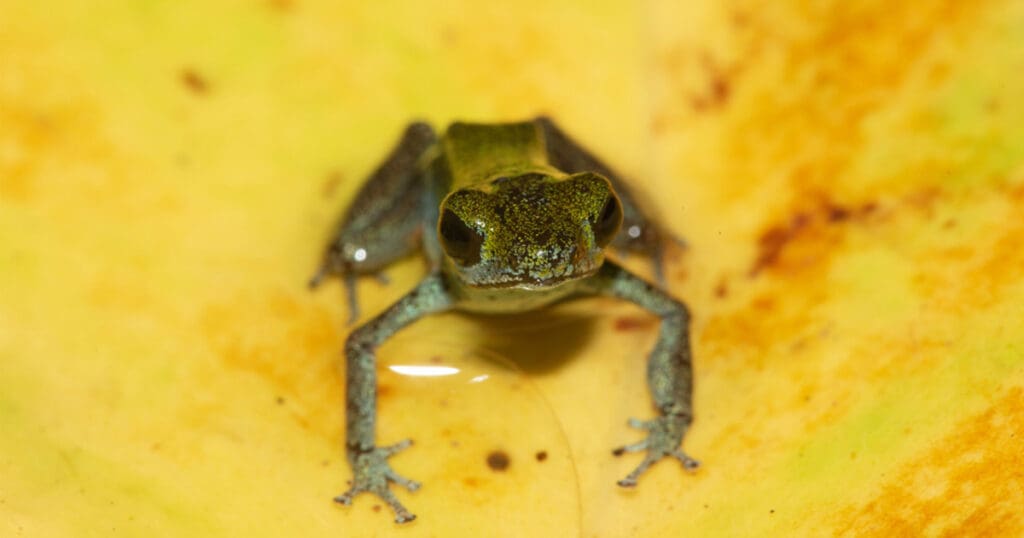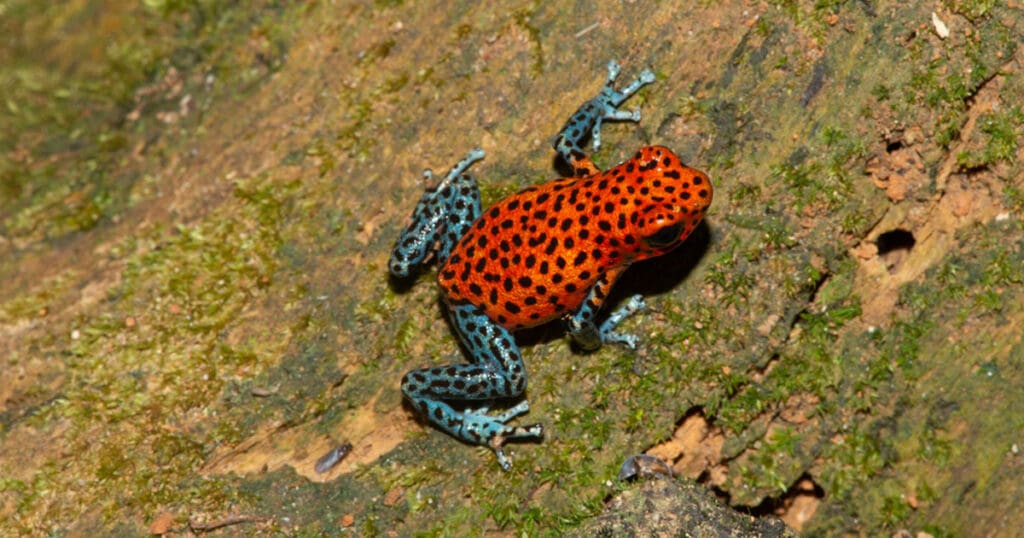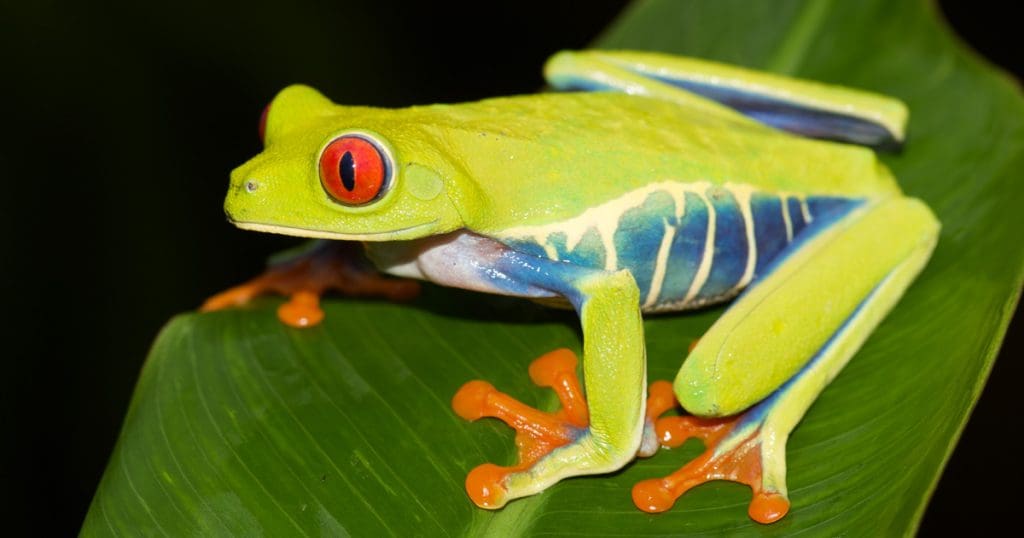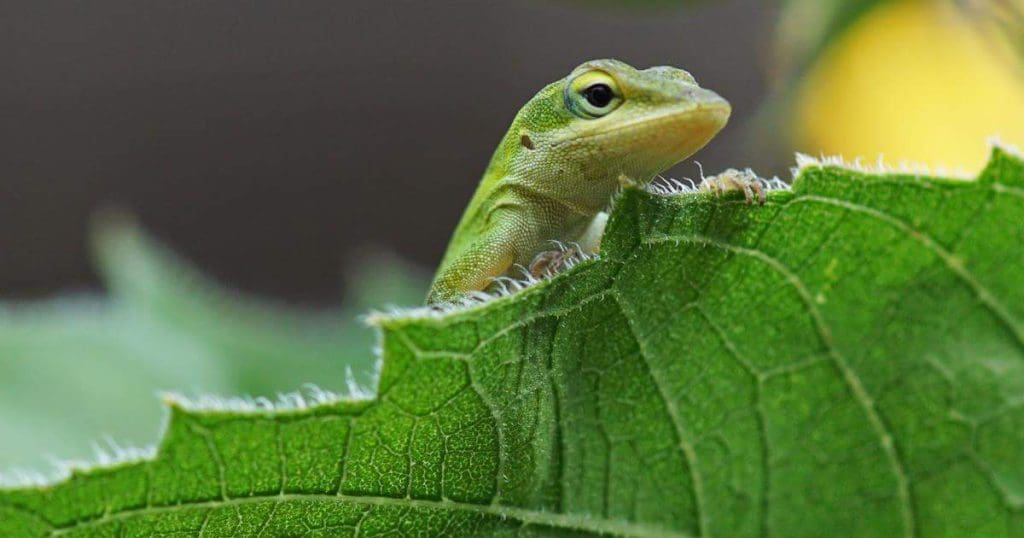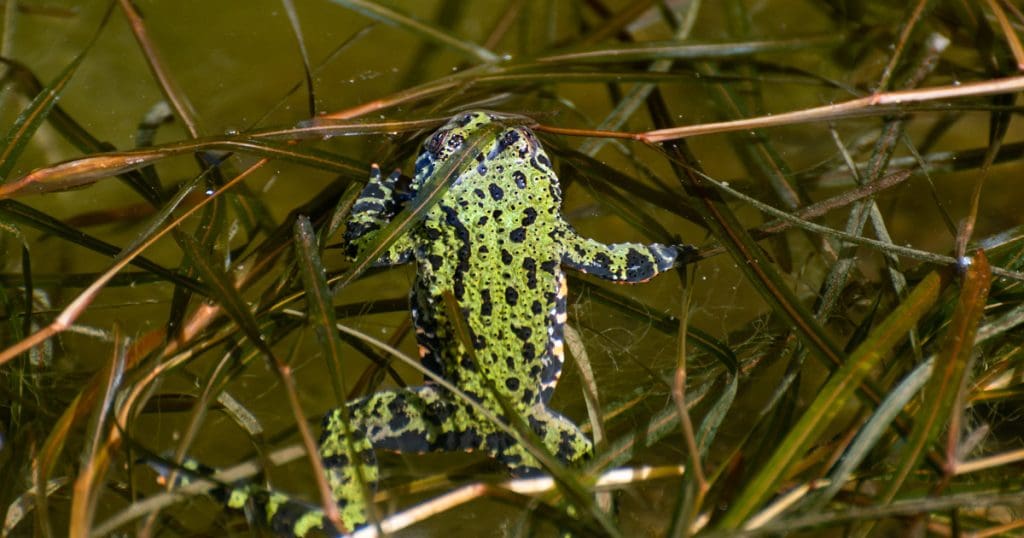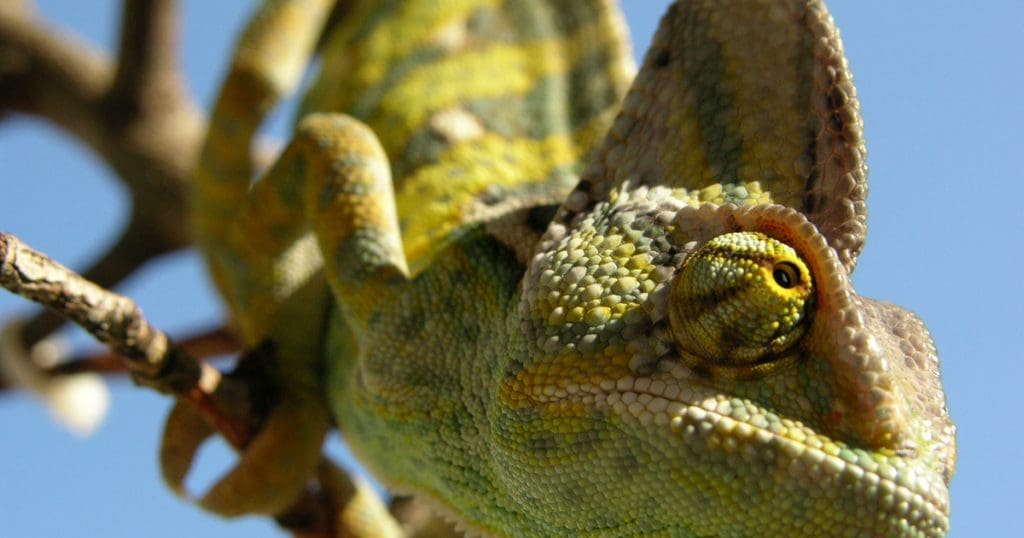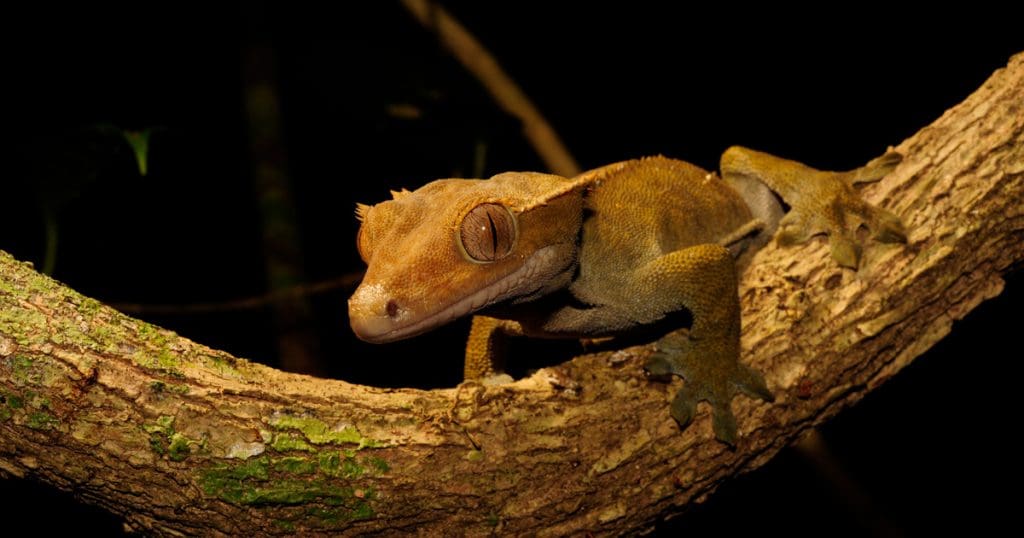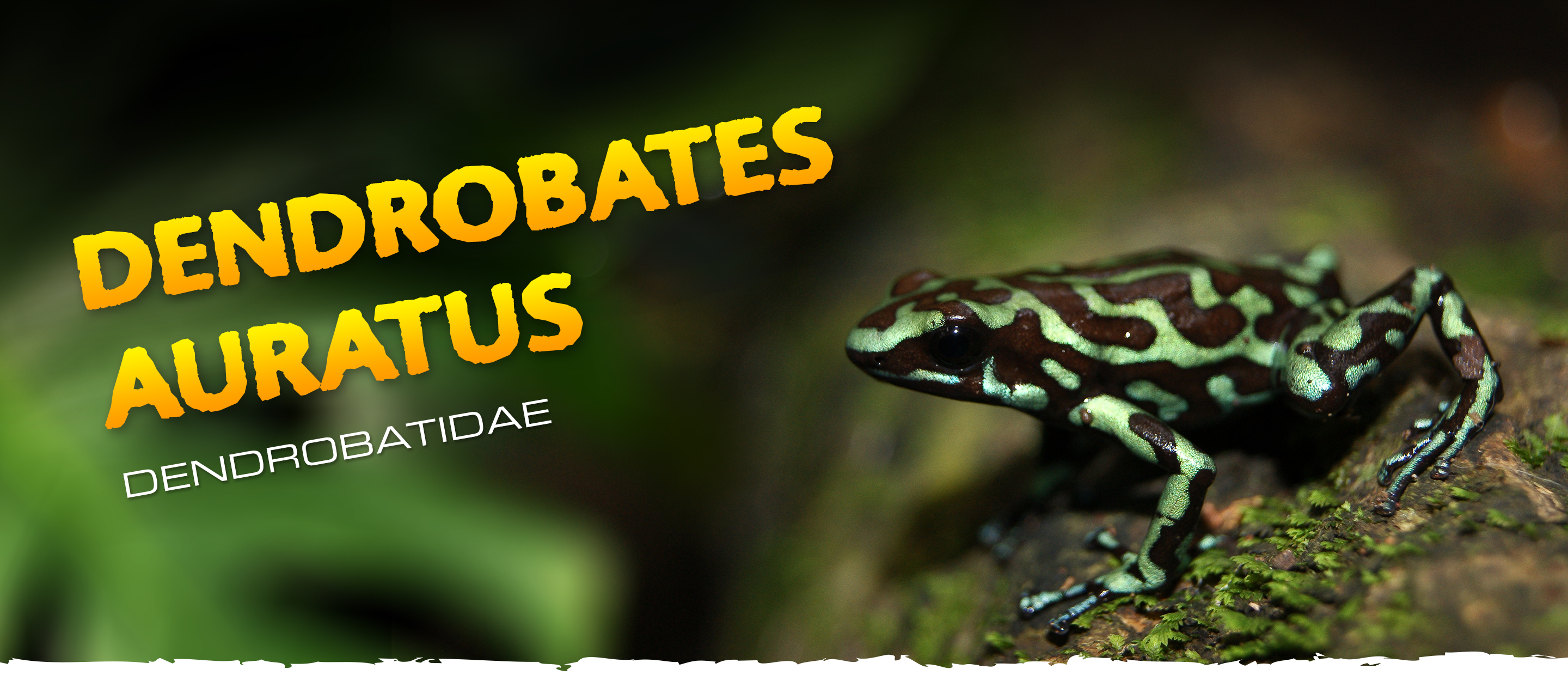
Dendrobates auratus
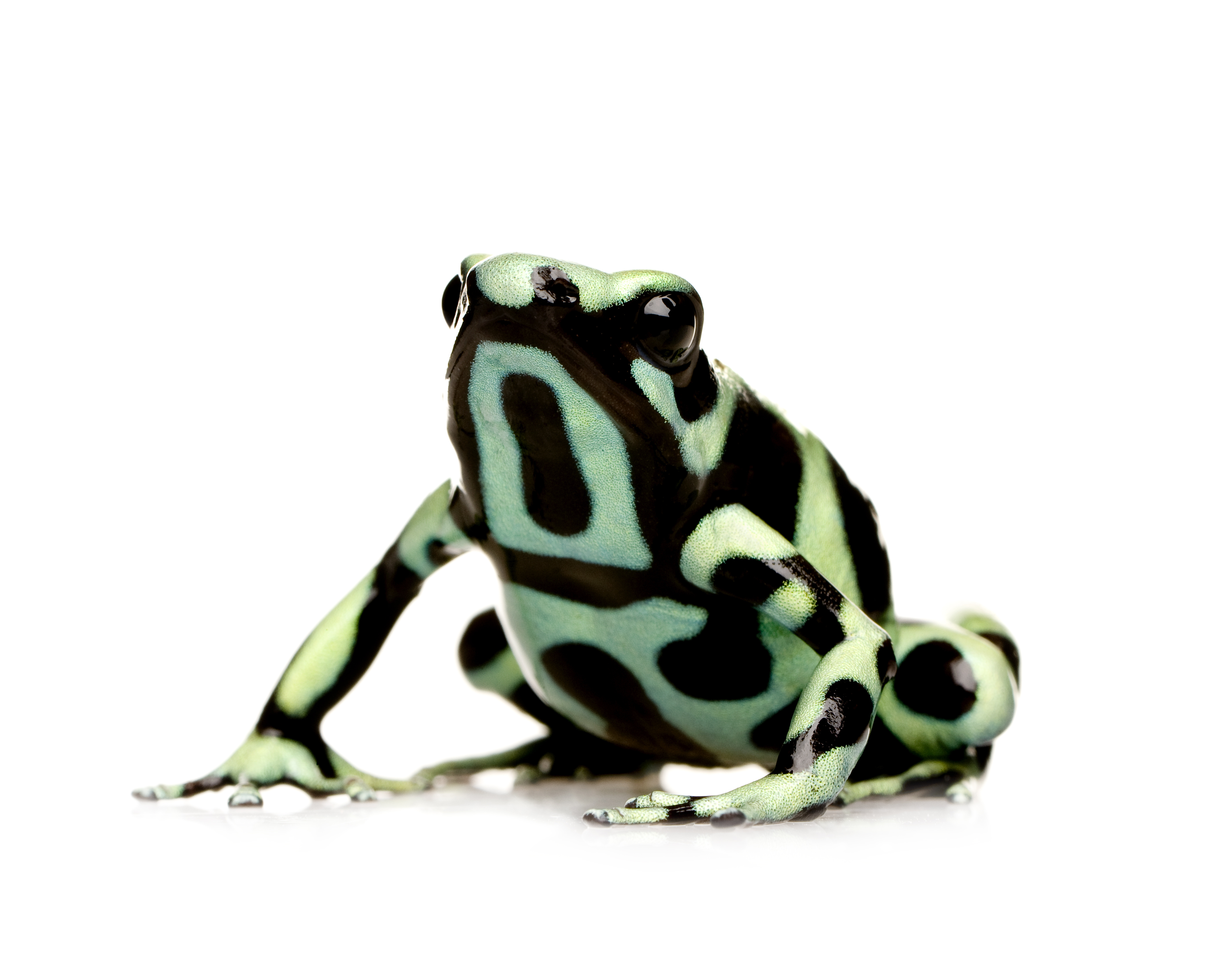

Black Green Poison Dart frog
The green-and-black poison dart frog, or Dendrobates auratus, is a captivating amphibian native to southeastern Nicaragua, Costa Rica, Panama, and northwestern Colombia. Recognizable for its long lifespan, the species is also notable for being relatively easy to care for, making it an appealing choice for hobbyists and researchers alike.
Its vivid mint-green base coloration punctuated with black splotches sets it apart visually. However, this species displays a fascinating trait known as color polymorphism. Individuals can exhibit varying shades, with base colors ranging from green to blue, yellow, and even white. The darker splotches, a characteristic signature of the species, vary from bronze to black.
Just like other poison dart frogs, their bright colors serve a crucial evolutionary purpose. They exhibit aposematic coloration, wherein the vibrant hues deter potential predators by signaling the frog's toxic nature, discouraging them from considering the frog as prey.
Primarily terrestrial, green-and-black poison dart frogs are bottom dwellers, spending most of their time navigating through the leaf litter blanketing the forest floor. However, they frequently venture upwards, climbing vines and trees in their tropical habitats.
These frogs are attractive display animals for beginner and advanced amphibian enthusiasts. Their stunning coloration, coupled with their relative ease of care, make them popular choices for terrarium inhabitants. They are best kept as pairs or in groups with most males, as females may exhibit aggressive behavior towards each other when vying for a specific male's attention.
Initially, these creatures may exhibit shy behavior. However, when housed in a well-planted terrarium offering plenty of hiding spots, they quickly become more active, adding a dynamic element to their display. With their intriguing behaviors, rich color variation, and their adaptability, Dendrobates auratus offer a unique glimpse into the vibrant world of amphibians.

History
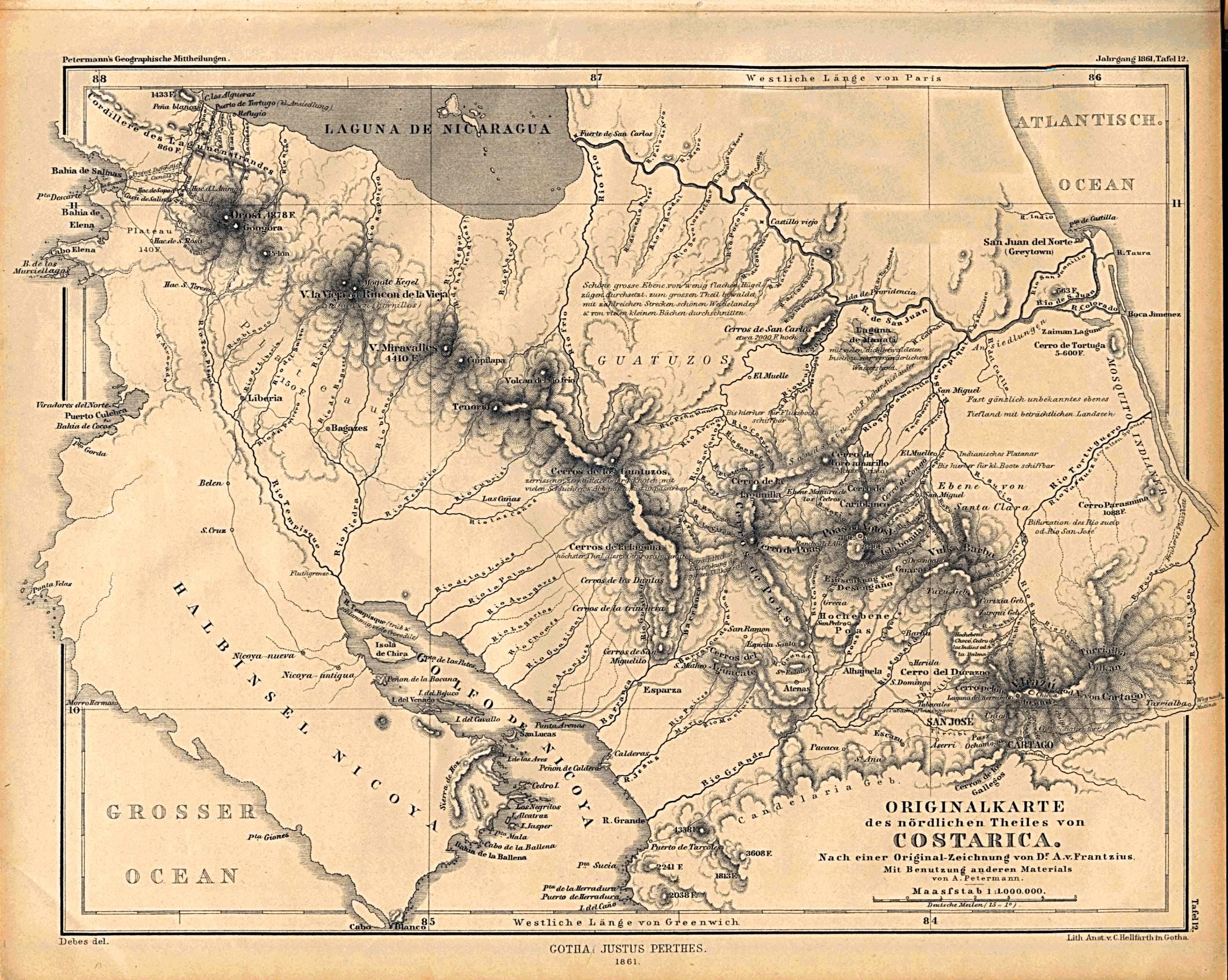
Dendrobates auratus, known as the green-and-black poison dart frog, has a rich scientific history, with its first formal description dating back to 1855. The species was detailed by the esteemed French biologist Charles Frédéric Girard, who specialized in ichthyology and herpetology, thus enhancing our understanding of these unique amphibians.
For over four decades, this species has been successfully bred in captivity in the USA and Europe, making it a familiar resident in zoos, research facilities, and private collections. The ability to breed them outside their natural habitats has not only facilitated their study and conservation but has also lessened the pressure on wild populations.
The name 'Dendrobates' is derived from the Greek words 'dendro' meaning 'tree', and 'bates' indicating 'walker' or 'climber'. This moniker aptly refers to the species' locomotion habits, moving through lower vegetation layers and scaling low bushes and tree trunks in their tropical forest homes. The species-specific name 'auratus' is Latin for 'golden', a descriptor reflecting the bronze- or gold-like shine of the darker splotches seen on some of their color morphs. Thus, the species' etymology beautifully captures its movement characteristics and visual allure, reflecting its natural history and captivating biology.
Characteristics
The green-and-black poison dart frog, Dendrobates auratus, belongs to the Dendrobatidae family and is a visually striking species that exhibits remarkable characteristics. This family comprises eight genera and over 170 species, all known for their vibrant hues and potent toxins.
The species' iconic, vivid coloration acts as an evolutionary warning system, signalling its toxic nature to potential predators. When threatened, Dendrobates auratus can secrete toxins from minute skin glands, creating a perilous poison-laden barrier. Intriguingly, when kept in captivity, these frogs lose their toxicity over successive generations, indicating the poison's source lies in their wild diet of tiny invertebrates. This demonstrates an extraordinary symbiotic relationship between the frog's diet and its self-defence mechanism.
Green-and-black poison dart frogs display color polymorphism, a phenomenon involving varied coloration within a species or population. This diversity, ranging from green, blue, and yellow to white base colors with darker bronze to black splotches, is believed to enhance species persistence and range expansion, reducing extinction risk. The prominence of the darker patterns varies across color morphs.
During mating season, male frogs demonstrate an interesting behavioral trait by selecting suitable egg-laying sites and attracting females with a soft rattling mating call, showcasing their role in reproductive tasks.
With adults measuring just 1” to 2" (2.5 to 5 cm) in total length, it's challenging to distinguish between genders. However, females often grow slightly larger on the same diet. Given proper care, these fascinating amphibians have an impressive potential lifespan of up to 20 years. This amalgam of attributes makes Dendrobates auratus a fascinating subject of herpetological interest.
Distribution
The green-and-black poison dart frog, scientifically known as Dendrobates auratus, has a unique geographic distribution. Endemic to regions of southeastern Nicaragua, Costa Rica, Panama, and northwestern Colombia, these amphibians have adapted to a wide range of environments. They inhabit areas from humid lowlands and plantations to lowland rainforests, spanning an impressive elevation range from sea level to 1400 meters. This altitudinal diversity exemplifies the species' notable ecological adaptability.
Moreover, the distribution of Dendrobates auratus extends beyond its native habitats. In a fascinating expansion, the species was intentionally introduced to O’ahu, Hawaii in 1932 as a biological mosquito control agent. Over the past decades, this vibrant frog has not merely survived, but successfully established itself in this novel environment, demonstrating its remarkable resilience and adaptability. This extended distribution further enriches the complex biogeographic story of Dendrobates auratus.
In the Wild
The green-and-black poison dart frog, Dendrobates auratus, leads a fascinating life in the wild. The species' name, 'poison dart frog', stems from indigenous tribes' practice of coating blow darts with these frogs' toxic secretions for hunting. It's believed that in times past, such darts also played a role in tribal warfare. The frogs, however, only produce this poison under extreme stress, such as when injured or threatened. Additionally, they do not synthesize the poison themselves, instead, they accumulate toxic substances from their diet and store these toxins in their skin.
These frogs are diurnal, hunting and foraging during daylight hours. They dwell mostly at the forest floor, amid the dense foliage and intricate root systems. Certain populations are also found near beaches or around intermittently drying rivers, showing their adaptive capabilities.
The mating rituals of Dendrobates auratus are particularly interesting. During the breeding season, male frogs search for suitable egg-laying sites, drawing in females with soft, rattling calls. Once a female deems a male suitable, he guides her to the selected site for egg deposition. Following fertilization by the male, the eggs develop into tadpoles within approximately two weeks.
When the tadpoles are fully grown, the male frog assumes a critical parental role. He carries the tadpoles on his back, relocating them to a small, permanent water body located higher in the terrain. Here, the tadpoles complete their metamorphosis into young frogs, marking the next generation of these remarkable amphibians. Through these behaviors, Dendrobates auratus paints a vivid picture of adaptation and survival in the wild.

In the Terrarium
When creating a terrarium for green-and-black poison dart frogs (Dendrobates auratus), several considerations come into play to ensure the well-being of these vibrant amphibians. Ideally, these frogs should be housed as pairs or groups with a majority of males. Female frogs may demonstrate aggressive behavior towards other females, particularly when competing for a male's attention.
Upon introduction to a terrarium, these frogs may exhibit initial shyness. However, a well-planted terrarium, offering plenty of hiding spots, encourages them to be more active and exploratory.
A notable feature of captive-bred poison dart frogs is that they pose no risk of poisoning. Their diet in captivity primarily consists of non-toxic invertebrates like fruit flies, springtails, and aphids. Unlike their wild counterparts, these captive-bred frogs lack exposure to toxic substances found in their native diet, leading to a non-toxic nature. Care must be taken when dealing with wild-caught specimens, as they may retain their toxins for several years.
These frogs are diurnal, thus feeding during the daytime aligns with their natural rhythms and minimizes stress.
Exo Terra’s Frogs & Co range provides a wide selection of products tailored for dart frogs and other frog species. These products are designed to work synergistically, helping hobbyists create a harmonized microhabitat that mimics the frogs' natural environment. Implementing the Frogs & Co range supports the creation of a bioactive, planted terrarium, which ultimately encourages a thriving population of green-and-black poison dart frogs, allowing for an immersive experience into the fascinating world of these extraordinary amphibians.


Terrarium
Crafted by European herpetologists, the Exo Terra® Natural Terrariums offer a variety of suitable housing options for green-and-black poison dart frogs. Made of glass, these terrariums are constructed with front-opening doors to facilitate easy access for feeding and upkeep, as well as a unique dual ventilation system complete with a stainless steel top.
The Exo Terra® Natural Terrarium X-Tall (Paludarium) is designed to create a semi-aquatic habitat that closely mirrors rainforests, swamps, or streams, providing a comfortable environment for both aquatic and terrestrial species. The Paludarium features an extra-high front bottom glass, allowing a higher water level and larger water volume than standard terrariums. Part of the aquatic section can be configured as a false bottom, supporting the land section, concealing aquatic appliances such as filters, pumps, and heaters, and functioning as a biological filtration media.
Given that green-and-black poison dart frogs aren't skilled swimmers, it's essential to maintain a shallow water depth that doesn't exceed the frog's height to prevent drowning incidents.
The Exo Terra® Dart Frog Terrarium comes equipped with an inbuilt drain and tap valve, providing an effortless means to remove surplus spray water. Its single front opening door enhances visibility and allows for easy maintenance and feeding access. Additionally, it features a push-button lock that secures the terrarium and can be supplemented with an optional lock to prevent unintentional opening.
With its hinged cover capable of full opening and locking or unlocking with a single button, it offers maximum convenience. A clear glass panel in the front facilitates maximum light penetration, while a stainless steel ventilation strip ensures optimal ventilation at the back.
The patent dual ventilation system keeps the front glass door free from condensation even under humid conditions, maintaining a natural airflow to ensure optimal conditions for the frogs. Any excess heat is dissipated through the top mesh, thus preventing temperature gradients in the terrarium. The mesh allows for UV and infrared penetration when required.
In terms of accessory installations, the terrarium offers four self-closing inlets at the back for powered accessories like waterfall pumps, filters, and the Exo Terra® Monsoon, among others. It also has Monsoon Nozzle mounting points on each side of the terrarium's inner front lid. The terrarium bottom becomes waterproof once the tubing, elbow connector, and tap valve are connected to the drain, facilitating effortless water changes and surplus water removal.
The Exo Terra® Frog Terrariums are adaptable for bioactive habitats suitable for dart frogs, smaller tree and reed frogs, newts and salamanders, small geckoes and lizards, garter and grass snakes, and so on.
For housing small groups of green-and-black poison dart frogs, horizontally oriented enclosures like the Low and Wide Natural Terrariums are an excellent choice, given the frogs' primarily terrestrial lifestyle.
Creating an ideal environment for your poison dart frogs involves the design and maintenance of a terrarium that emulates their natural habitat. Your setup can vary from a basic "forest floor" theme to a more intricate bio-active style featuring separate terrestrial and aquatic sections. The latter can mirror a lake or riverbank setting, especially when furnished with the Bio Drain system.
Equip your terrarium with an assortment of secure hides, such as Coconut Caves, and cover the substrate with a thick layer of leaf litter, employing something akin to the Equatorial Forest Floor substrate. This creates an environment filled with places to explore and hide, similar to their wild habitat.
Introducing both artificial and live plants not only enhances the aesthetic appeal of your terrarium but also contributes to replicating the natural environment of the dart frogs. A well-furnished terrarium provides the poison dart frogs with a wealth of substrate, foliage, and secure hiding spots, allowing them to thrive comfortably.
The terrarium's placement in your home is equally vital. Avoid direct sunlight by placing the terrarium in a room that receives only indirect light from windows. Exposure to direct sunlight can overheat the terrarium, leading to stress or even death of your poison dart frogs.
Finally, when deciding on the type and number of frogs for your terrarium, ensure you comply with the species-specific rules and regulations in your country of residence. Balancing the creation of an optimal living environment with legal requirements is essential in keeping a harmonious terrarium.
Lighting
A 12-hour day/night cycle will benefit your frogs and stimulates live plant growth. The Exo Terra® TerraSky Planted Terrarium Light is ideal for planted setups, paludariums and bioactive terrariums. The high intensity and enhanced penetration ensure that the light reaches all layers of the terrarium, resulting in sustained lush plant growth. Orchids, Bromeliads, Tillandsias (air plants), carnivorous plants, mosses and lichen all thrive under the TerraSky Planted Terrarium Light’s strong Photosynthetic Active Radiation (PAR). The 120-degree light dispersion provides a nice even illumination and covers the complete area to avoid dark spots.
Providing UV-lighting is not absolutely necessary, but the correct amounts of UVB will help your frogs to metabolize calcium and prevent metabolic bone disease. The combination of the correct UVB wavelength and heat enables the animals to produce their own vitamin D3 for proper calcium absorption and prevents metabolic diseases (e.g., MBD). We highly recommend the use of our Reptile UVB100. The low levels of UVB rays produced by these bulbs are very beneficial for the animal's overall health, while the UVA rays stimulate appetite, activity and reproductive behavior.
Heating
Monitoring
During the day, an average relative humidity of 70-80% and room temperature of 75-79°F or 24-26°C should be maintained. At night, humidity should rise up to about 100% and room temperature can drop with 4-8°F (2-4°C). Use the Exo Terra Digital or Analog Thermometers and Hygrometers to help you monitor the terrarium conditions and adjust the temperature and relative humidity to meet the needs of the animals.
For more security and peace of mind, the Exo Terra® Thermostats or Thermostat & Hygrostat will help to prevent overheating and undercooling during hot summer days or cold winter nights. Apart from the temperature, the Exo Terra® Thermostat & Hygrostat will also keep the humidity at the desired level. With the Exo Terra® Thermostats or Thermostat & Hygrostat, you can create a well-controlled heating/humidifying system that allows you to maintain the required temperature and/or humidity conditions similar to those found in your animal's environment.
Substrates
For the vibrant Dendrobates auratus, or the Green and Black Poison Dart Frog, creating a bioactive terrarium environment that closely mimics their natural habitat is key. Begin with a base layer of Exo Terra's Bio Drain Substrate which ensures efficient drainage. A non-toxic barrier mesh separates this from the top layer, preventing substrate particles from contaminating the water. The top layer should be a balanced mix of Exo Terra's Plantation Soil and Forest Moss. This combination provides an absorbent and biodegradable substrate that maintains ideal humidity levels, supports beneficial microbial activity, and fosters the growth of microfauna, providing a self-sustaining ecosystem for your amphibians.
Exo Terra® presents a range of ecologically sound substrates, each contributing uniquely to recreate natural habitats in your terrarium and promoting a living ecosystem.
1. Exo Terra® Sub Stratum: A natural volcanic soil enriched with live beneficial bacteria. Its porous surface and low-density structure allow excellent aeration and drainage, stimulating the growth of beneficial nitrifying bacteria. These bacteria decompose biological waste, maintaining a clean, healthy terrarium. The Sub Stratum can be mixed with other organic substrates to provide essential minerals like calcium, nitrogen, potassium, and phosphorus, enhancing water retention and root aeration.
2. Exo Terra® Equatorial Forest Floor: A multi-layer substrate that recreates the natural equatorial forest floor. The base layer, made from ground coconut husk fiber, is organic, biodegradable, and has hygroscopic properties. The top layer, composed of sun-dried Ardisia leaves, covers the substrate, facilitating moisture retention and preventing dryness.
3. Exo Terra® Forest Moss: A real compressed moss from tropical Asia, free from dyes or chemicals. This absorbent substrate increases the terrarium’s humidity, safe for frogs, salamanders, and burrowing or digging animals.
4. Exo Terra® Plantation Soil: A 100% natural, biodegradable substrate made from sustainable, ground coconut husk fiber. Its unique hygroscopic properties naturally regulate the terrarium’s humidity, suitable for frogs, salamanders, and other burrowing animals. The soil's improved aeration promotes the cultivation of waste-reducing organisms, keeping the terrarium clean.
Moisture management is crucial. The substrate should be kept moist, not soaking wet, with varied moisture gradients within the terrarium. This can be achieved by spraying more frequently during warmer seasons. Exo Terra® substrates, along with a top layer of Equatorial Forest Floor or Forest Moss, help maintain optimal moisture levels and prevent dryness. This top layer also provides hiding spots for the inhabitants and encourages the natural ecosystem where beneficial organisms break down waste, reducing odours.
Remember, healthy plants depend on healthy soil, teeming with living microorganisms – bacteria, fungi, protozoa, and arthropods. They choreograph a vital exchange from nutrient recycling to the decomposition of organic materials, contributing to a vibrant terrarium ecosystem.
Plants
A lush, well-decorated terrarium can mimic the natural surroundings of Poison Dart Frogs, promoting their well-being. This habitat can incorporate both live plants and Exo Terra's convincing artificial varieties. Live flora, such as small fern species, epiphytes, Bromelias, Tillandsias, orchids, moss, and small-leaved vines, not only contribute to a visually appealing setup but also aid in natural biological filtration, enriching your ecosystem.
Exo Terra's Dart Frog Bromelia is a superb addition to any terrarium. Designed to resemble the bromeliads commonly found in frog habitats, its waxy overlapping leaves provide a platform for female frogs to lay eggs. Moreover, the urn-shaped rosette collects water, a much-needed resource for the frogs and their tadpoles, and is detachable for convenience in cleaning and tadpole collection.
Planting live plants in pots buried in the substrate, camouflaged with decor items like cork bark or rocks, is another effective strategy. The Exo Terra Snake Bowl serves as a splendid decorative planting pot, thanks to its extra deep design suitable for small to medium plants. Remember, before introducing any plant, ensure they are pest-free and rinse the leaves thoroughly to eliminate possible pesticide residues.
Complementing live plants with Exo Terra's artificial plants offers numerous benefits. These replicate the aesthetics of their natural counterparts and provide shade, hiding spots, and visual barriers, contributing to a sense of safety and reduced stress for your pets. They require less maintenance and are ideal for hotter or dryer terrarium sections. The collection includes Bromeliads, Scindapsus, Philodendrons, and hanging plants, all easy to clean and maintain, with weighted bases for straightforward positioning post-maintenance.
Hide Outs
Green-and-black poison dart frogs are naturally introverted creatures, exhibiting shy behavior that can be mitigated with the provision of ample hiding places. These frogs are exceptionally sensitive to environmental disturbances and can retreat swiftly to cover when startled. However, paradoxically, they are more likely to venture out in the open and exhibit their vibrant hues when they have numerous secure hiding spots. This behavior can be attributed to the reassurance these spaces provide - knowing a safe retreat is always close at hand gives them the confidence to explore their surroundings.
The Exo Terra Coconut Cave is an ideal solution to meet these requirements. It is designed with the frog's natural preferences and offers an optimal hiding and egg-laying spot for your poison dart frogs. The cave's design fosters a sense of safety and comfort for these delicate creatures, encouraging them to display more of their natural behaviors and, ultimately, enhancing your observation opportunities.
Adding to the appeal of the Coconut Cave is its ability to integrate seamlessly into the terrarium's ecosystem. In the consistently moist environment typical of a dart frog habitat, its irregular surface is conducive to moss growth. This enhances the cave's natural appearance and further augments its appeal to the frogs, creating an environment that mimics their native habitat. Therefore, the Exo Terra Coconut Cave is more than just a functional addition to your terrarium - it is an essential component for promoting the well-being of your Green-and-black poison dart frogs.
Decor
Landscaping a terrarium will not only encourage the frog's activity and exploratory behavior, but also provide extra cover, which increases the frog's sense of security and reduces its stress levels.
While providing necessary elements such as leaf litter, plants, and hideouts, it's also rewarding to enhance the aesthetics of your terrarium. However, careful attention must be given not to overpopulate the open space, ensuring a balance between functionality and visual appeal.
Adding Waterfalls and Cascades is a creative way to enrich the visual spectacle of your terrarium. Besides the aesthetic value, these additions also contribute to the habitat's health by oxygenating and biologically filtering the water. This feature simulates a more natural environment for your amphibians and creates a dynamic and engaging display for observers.
Exo Terra offers an innovative range of decor items that can lend a personal touch and increase the environmental enrichment of your terrarium. These include Skulls, Waterfalls, Smart Plants, and Ground Cover Plants. Each product is thoughtfully designed to enhance the visual aspect while contributing positively to the terrarium's ecosystem.
The Skulls offer unique hiding spots, promoting the natural behavior of your creatures. Smart Plants contribute to the natural look of the habitat and can also serve as hideouts or egg-laying sites. Ground Cover Plants are easy to install and provide visual barriers and shelter.
Remember, while personalizing your terrarium, it's crucial to consider the needs and behaviors of its inhabitants. A well-planned, beautiful terrarium can contribute significantly to your amphibian's health, happiness, and longevity while providing an intriguing visual centrepiece for your space.
Nutrition
The Green-and-black Poison Dart Frogs primarily thrive on a diet of miniature live insects and other arthropods. A staple diet can consist of fruit flies supplemented with various other live prey. This could include aphids, springtails, bean beetles, rice flour beetles, small fly larvae, and pinhead crickets. Ensure the length of the prey is at most 3 mm or 0.1 inches, as the frogs might struggle to consume larger prey.
Given the nutritional inadequacy of commercially raised insects, it's crucial to enhance their nutritional value by coating them with a reptile vitamin and mineral supplement. Exo Terra® Multi Vitamin, combined equally with Exo Terra® Calcium + D3 powder supplement, is recommended for this purpose. Use the "shake & bake" method to coat feeder insects thoroughly. This process involves placing the insects and the supplement powder in a bag and gently shaking them until they're entirely coated.
Feeding frequency varies with the frog's age. Juveniles require daily feeding, while adults can be fed every second or third day. Be mindful of overfeeding, as it can cause undue stress to the frogs. As a guideline, provide only what your frogs can consume within two minutes.
It's also important to maintain variety in their diet. This ensures they receive a balanced array of nutrients and mimics their natural feeding habits in the wild, contributing to their overall well-being and satisfaction in captivity. You can help your Green-and-black Poison Dart Frogs thrive and live healthily with mindful feeding practices.
Water
Clean, fresh water is paramount in the successful care and maintenance of captive reptiles and amphibians, including Dart Frogs. These frogs have thin, permeable skin making them vulnerable to dehydration and sensitive to harmful chemicals. Instead of drinking, they hydrate through skin absorption, necessitating a high-humidity terrarium environment and meticulous attention to water quality.
Using a product like Exo Terra® Aquatize is advised to treat tap water, eliminating damaging heavy metals, chlorine, and chloramines, to provide a healthy water source for your amphibians. In a bio-active setup, Turtle Clean (PT1998) introduces beneficial organisms into the terrarium water to boost biological filtration capabilities. Adding Liquid Electrolyte and Calcium to the water can promote healthy bone and muscle growth in frogs and tadpoles.
Ensure a shallow water dish filled with clean, de-chlorinated water is accessible at all times. Exo Terra® Water Dishes, specifically the Frog Ponds, are perfect choices due to their shallow depth, natural appearance, and ease of cleaning and disinfecting. The Frog Pond's unique design can be semi-recessed into the substrate, imitating a riparian zone, thus offering easy hydration access for the frogs and preventing drowning with its shallow water body and integrated steps.
Green-and-black poison dart frogs are not swimmers, so the water body depth in your terrarium should never exceed the frog's height. If necessary, use Exo Terra® Turtle Pebbles to decrease water depth.
Maintain average humidity between 70-80%, with peaks of 100% during mornings and evenings, which mimics their natural environment. Devices such as the Exo Terra® Monsoon offer timed, daily terrarium spraying. The Exo Terra® Humidifier, when used with the Exo Terra® Thermostat & Hygrostat, assists in maintaining the correct relative humidity levels. Despite the need for high humidity, minimal ventilation is essential to prevent fungus growth and plant rot. The patented dual ventilation system of Exo Terra® Natural Terrariums and Frog Terrariums delivers ideal ventilation levels without compromising the required relative humidity.
Maintenance
Caring for your Green-and-black Poison Dart frogs requires dedicated maintenance of their terrarium environment, divided into the land area and the water part.
Land area maintenance involves spot-cleaning the enclosure at least once a week, more if required, to prevent harmful bacterial buildup. This process removes fresh or dried feces, leftover food, and other waste. For thorough cleaning, take out all decor items and wash them with warm water. Mix the moist substrate, stirring, allowing soil bacteria to break down residual waste. Pay attention to the substrate condition - it only needs replacing if it starts to degrade or emits a foul odor. Regular spot cleaning is adequate as long as these conditions aren't present.
In the water part, if you use a water circulation pump or filter, ensure its water inlet and filter media are cleaned every 2-3 weeks for optimal performance. Conduct bi-weekly partial water changes, replacing about 1/4 to 1/3 of the water with fresh water of suitable temperature—these partial changes aid in removing toxins and improving water quality. Avoid complete water changes, as they also eliminate beneficial bacteria and organisms. Treat tap water with Aquatize during water changes to remove harmful heavy metals, chlorine, and chloramines. Utilize Turtle Clean (PT1998) to maintain ideal levels of beneficial organisms in the terrarium water, ensuring a well-performing biological filtration system.
Feed juvenile Dart Frogs daily and adults every second or third day. Misting the terrarium at least twice a day is critical, depending on relative humidity levels, and it's preferable to use purified or distilled water to avoid mineral stains on the glass. Give live plants sufficient water, whether potted or planted in the substrate, once a week.
Clean the inside glass and decorations with plain water once or twice weekly to remove waste. Use a paper towel and window cleaner to clean the exterior glass, but never apply window cleaner on the inside glass.
Breeding
In their natural habitat, the breeding season of Green-and-black Poison Dart Frogs coincides with the rainy season, spanning from May to November. To encourage breeding in captivity, mimic this rainy season after a period of dryness by amplifying both the frequency and duration of your misting system's spray intervals.
Dart frogs, unlike many other frog species, do not participate in amplexus. The male of this species searches for an ideal egg-laying location, often favoring a dimly-lit hide with a smooth bottom surface. Hides like the Exo Terra® Coconut Cave offer a prime environment for your dart frogs' egg-laying. Upon finding an appropriate site, the male will attract a female with his soft, rattling mating call. Guided by the male's call, the female will follow him to the chosen location and lay between 5 to 20 eggs, which the male then fertilizes.
Over the course of approximately two weeks, these eggs will evolve into tadpoles. As each tadpole matures, the male carries it on his back to a higher, stable, and small water body for further growth and metamorphosis. The rosette of the Exo Terra® Dart Frog Bromelia offers a naturalistic replication of these elevated water bodies.
Once the tadpoles commence swimming, they begin feeding on frog & tadpole food, deceased insects, cut-up earthworms, fish food flakes, algae, plants, and so on. Their full metamorphosis into air-breathing amphibians usually takes between 2-4 months. At this stage, ensure the metamorphosing tadpoles have plenty of plants, branches, or smooth riverbank access to an easy transition to the land area.
Upon emergence, the newly transformed froglets will absorb their tail remnants for several days and then start feeding on suitably sized food items such as fruit flies and aphids. As with adults, be sure to dust feeder insects with a 1:1 mix of Exo Terra® Multivitamin and Calcium + D3 powder supplement. The young frogs can thrive under similar conditions as the adults, provided the water isn't too deep and there are slopes available to aid their transition to land areas.
Handling
While the intrigue of Poison Dart Frogs might inspire a desire to handle them, it is strongly advised against it unless necessary. The potential danger is even more pronounced with wild-caught specimens, as their skin can retain poisonous characteristics for several years post-captivity. Therefore, when handling such frogs is essential, wearing rubber gloves is a recommended precaution.
Poison Dart Frogs are primarily observational creatures not receptive to being picked up or handled. Interactions can quickly induce stress in these amphibians. Like their kin, Dart Frogs possess susceptible skin and are particularly susceptible to chemicals such as soap, lotion, etc. So, if handling is unavoidable, it's essential to thoroughly wash and rinse your hands with warm water both before and after touching any amphibian.
Furthermore, the skin of all amphibians contains mildly toxic substances that can irritate eyes or open wounds. If you inadvertently touch your eyes after handling an amphibian, you might experience a burning sensation. If this occurs, promptly and thoroughly rinse your eyes with water, which should provide immediate relief. Once again, the most effective preventative measure is to thoroughly wash and rinse your hands with warm water before and after interacting with these fascinating creatures.

Conclusion
The Green-and-black Poison Dart frogs are captivating creatures with vibrant colors and distinctive patterns, making them an appealing choice for amateur amphibian enthusiasts. They are renowned for their longevity and relatively straightforward care requirements, attributes that enhance their suitability for beginners.
One of the many captivating aspects of these frogs is their striking variation in color and pattern morphs. These attributes and their small size make them ideal inhabitants for richly decorated, plant-filled terrariums. Unlike larger amphibians, these petite frogs are gentle on delicate flora, including species as fragile as orchids. This allows you to fashion an enthralling, diverse, and colorful microcosm that mirrors the lush ecosystems of the rainforest, bringing together both fauna and flora in a single, beautifully curated space.
Captive breeding of Dendrobates auratus has been successfully practiced in regions like the USA and Europe for over four decades. This has resulted in the wide availability of these captivating creatures in reptile stores and with breeders. Moreover, young captive-bred specimens are easily accessible, enhancing their suitability for beginners. This means you can start your journey into the fascinating world of amphibians with a species that's not only visually stunning but also ethically sourced and straightforward to care for.

Did You Know?
Green-and-black Poison Dart frogs' toxicity works as a defense mechanism against predators, but also prevents bacterial and fungal infection. Their thin, highly permeable skin makes them extra susceptible to these types of infections. In humid environments, where both fungus and bacteria thrive, this is a very welcome trait.
Green-and-black Poison Dart Frogs were intentionally introduced to the upper Manoa Valley on the island of O’ahu, Hawaii in 1932 as a biological control measure against mosquitos and the species is now well established.
Contrary to other frog species, Green-and-black Poison Dart Frogs take care of their offspring. The eggs are guarded and protected by the parents during the development. Once the tadpole is fully grown, one of the parents (typically the male) will transport the tadpole to a small pool of water. But, it does not stop here: the parents will keep guarding the tadpole while it feeds and grows inside this tiny pool, until it reaches the final stage of its metamorphosis.
Frequently Asked Questions
Is a Green-and-black Poison Dart Frog the right choice for me?
Green-and-black Poison Dart Frogs are great animals; they are beautiful, long-lived and “easy-to-care-for”, and on top of that, they come in a variety of color & pattern morphs. Keep in mind that Green-and-black Poison Dart Frogs are display animals, they don't like to be handled. If you are intrigued by the rainforest ecosystem, they are the perfect choice. Their small size does not endanger the wellbeing of fragile plants like orchids, which allows you to recreate a complete piece of this beautiful ecosystem, including live plants, flowers and mosses. Green-and-black Poison Dart Frogs are readily available and they're captive bred, making them safe animals to start with.
Should I feed a variety of food items to my Green-and-black Poison Dart Frog or can I stick to just 1 type feeder insect?
Bring as much as possible variation in your Green-and-black Poison Dart Frog’s diet to make sure that your frog receives all possible essential nutrients.
Can I keep other species of amphibians and reptiles together with my Green-and-black Poison Dart Frogs?
Hobbyists have reported good as well as bad experiences in regards to keeping this species together with other species. In general, we would advise that Green-and-black Poison Dart Frogs should definitely not be kept together with other bottom dwelling and/or diurnal species, as this could create a stressfull environment.
Are Green-and-black Poison Dart Frogs poisonous?
Poison dart frogs that are bred in captivity do not pose a risk of poisoning. The frogs are fed with fruit flies, springtails, aphids and other tiny invertebrates, which lack the toxic substances that are used by their wild counterparts to store in their skin. On the contrary, when handling wild caught frogs, precautions should be taken, as it might take up to several years before all the toxins have disappeared.
Can I feed my Green-and-black Poison Dart Frogs wild caught insects?
We do not recommend feeding wild caught insects as these can harbor harmful bacteria. They may also have come in contact with gardening chemicals, making them poisonous for your Frogs.

Notes from the Field
Isla Bastimentos
The island was named by Christopher Columbus who landed here in 1502 and called the island Bastimentos which means “provisions” – as the island was used to restock supplies for his fleet. The north eastern side of Bastimentos Island faces the Caribbean Sea where all the beaches can be found. The most famous is Red Frog Beach, which got its name from the red Oophaga pumilo morph that inhabits the forest near the beach. The island’s south western side is lined with dense, lush mangroves and enjoys calmer waters, partially due to the water’s shallow depths. The Exo Terra research vessel anchored near Red Frog Marina between Isla Bastimentos and Isla Solarte.
Isla Colon
San Cristobal is one of the larger islands with a limited human population which is scattered throughout the island and in a couple of small communities. The island’s forests are fragmented. The Exo Terra team sailed with the research vessel to the northern tip of the island where there is easy access to the degraded and primary forests. Oophaga pumilio was almost immediately located, even in the degraded forest patches at the edge of the banana plantations. This population was primarily observed on the forest floor near tree bases. The frogs at San Cristobal are extremely variable, with a red to orange dorsal colouration and blue legs. Some are dotted, while others are patternless.
Isla Escudo de Veraguas
The first destination was the remote Isla Escudo de Veraguas, a small isolated Caribbean island of about 4 square kilometres. It is part of the Bocas del Toro district and located about 20 km from the coastline in the Golfo de los Mosquitos. Because of its 9000 years of isolation, several animals found here are endemic or distinct from their mainland counterparts. It took the team about 9 hours of rough seas in the pouring rain and strong winds to reach this uninhabited island. The most challenging part was to get ashore with the smaller boat due to the extreme surf and strong currents, even on the most protected southern coast of the island. Once on land the rough journey was quickly forgotten due to the sheer beauty of this island, and the Exo Terra team was immediately greeted by several brown basilisks (Basiliscus vittatus). These lizards, also commonly referred to as the striped basilisks, occur from Mexico to northwestern Colombia. The brown basilisk has large hind feet with flaps of skin between each toe. They move quickly across the water, aided by their web-like feet, which gives them the appearance of “walking on water”. Once entering the rainforest, it became clear that the ability of Basiliscus vittatus to “walk on water” is a great advantage. The interior of the island consists of a peat swamp forest. A type of tropical moist forest where waterlogged soil prevents dead leaves from fully decomposing. Over time, this creates a thick layer of acidic peat. This peat is covered with stained dark brown water caused by the tannins that leach from the fallen leaves and peat. A drone flight later on showed that almost the entire island is covered by such a swamp forest, making it nearly impenetrable. The team had great difficulties moving around as there are no dry paths and with every step they sunk up above the knee and higher into the acidic peat. The only “dry” patches were around the bigger trees and between the roots of the fig trees. That is where the most spectacular Oohaga pumilio morph can be found. The animals are so contrasting and conspicuous that they easily can be located without the help of a calling male Biotope on Colon to reveal their location. The high water in the swamp and the continuous rains made it almost impossible to move around and prevented the Exo Terra team from penetrating deep inland. As a result very few other animals were observed, besides the occasional anole on tree trunks or low hanging lianas. One exciting find was the eyelash viper (Bothriechis schlegelii) on one of the many raffia palms. The eyelash viper is a venomous pit viper found throughout Central and South America. It is a small and arboreal species, characterised by a wide array of colour variations, as well as the superciliary scales above the eyes. The severe weather conditions forced the team to be picked up early from the shore as the surf increased significantly due to the strong winds. Some team members even had to swim back to the research vessel as the small boat was only able to pick up the camera and logging gear. A scary adventure by itself! Unfortunately the weather conditions didn’t improve overnight, and the vessel was forced to leave this amazing island.
Isla Loma Partida
Unfortunately weather conditions didn’t improve during the night and when the expedition set course to Cayo Agua it became clear that landing on this island would be extremely difficult. Cayo Agua is one of the most western islands of the Bocas del Torro archipelago and immediately exposed to the high seas of the Caribbean See. Although an interesting morph of Oophaga pumilio with yellows and whites can be found there, the team had no choice but to sail deeper into the Chiriqui Lagoon for protection.
Isla Popa
Isla Popa is the second-largest island of the Bocas del Toro archipelago and lies less than 200 m from the mainland. Although most of the island is low-lying—below 100 m elevation—the topography is rugged, with deep ravines and several small, permanent streams.
The vegetation is dominated by humid forests, while the coastal areas consist of mangrove swamps, sedge marshes and grass-covered hills. Extensive thickets cover the forest edges and the many bananas and plantain plantations.
Isla San Cristobal
San Cristobal is one of the larger islands with a limited human population which is scattered throughout the island and in a couple of small communities. The island’s forests are fragmented. The Exo Terra team sailed with the research vessel to the northern tip of the island where there is easy access to the degraded and primary forests. Oophaga pumilio was almost immediately located, even in the degraded forest patches at the edge of the banana plantations.
Other species
Agalychnis callidryas
Red-Eyed Tree Frogs are native to Mexico, Belize, Guatemala, Honduras, Nicaragua, Costa Rica, Panama and even occur in some isolated populations in Colombia. They primarily prefer tropical rainforests and humid lowland forests but can sometimes be found in humid forests on premontane slopes up to 1250 m above sea level.
The Red-Eyed Tree Frog's common name refers directly to the beautiful, big red eyes that these frogs show at night. Red-Eyed Tree Frogs are sometimes referred to as Red-Eyed Leaf Frogs as well because of their arboreal lifestyle, sleeping on the back of the leaves in the trees and shrubs that they live in.
Red-Eyed Tree Frogs are stunning, long-lived and relatively “easy-to-care-for” amphibians. Their engaging personalities, their huge bright red eyes, bright green dorsal color with blue striped sides, and their bright orange webbed feet, make them one of the most stunning display animals for both the beginning reptile enthusiast as well as for the advanced hobbyist.
Red-Eyed Tree Frogs are a fairly social species and are best enjoyed when kept in small groups of 4 to 8 animals. The interaction between the animals in these small groups increases the viewing pleasure but also stimulates their mating behavior.
Red-Eyed Tree Frogs have been captive bred in the USA and Europe for more than 30 years. They are available in various local color variations and even an "albino type" morph with yellowish dorsal coloration and silver eyes called "lutino" is sometimes offered.
Anolis carolinensis
Green Anoles are native to the Southeastern United States, but have also been introduced to Hawaii, Ogasawara Islands of Japan, Cuba, the Bahamas, and Guam. Green Anoles are diurnal, primarily arboreal, iguanid lizards of the Genus Dactyloidae. Green Anoles mostly inhabit trees and shrubs in tropical & subtropical evergreen forests, but can just as well be found in open grassland with only a few trees, and even in rural and urban areas.
With their changing base color from brown to vivid green, their reddish-pink colored dewlap and their interesting displaying behaviour, these terrarium inhabitants rank among the most popular and easiest to keep beginner reptiles.
Green Anoles are a fairly social species and are best enjoyed when kept in small groups of 1 male with 3 or more females. The interaction between the animals in these small groups increases the viewing pleasure but also stimulates their mating behavior.
Green Anoles have been captive bred in the USA and Europe for more than 30 years. Green Anoles are available as captive bred specimen as well as wild-caught specimen using sustainable ranching and size-selective harvesting.
Bombina orientalis
Fire-Bellied Toads are endemic to Northeastern China, Korea, and the Khabarovsk and Primorye regions in Russia. Despite their common name Fire-Bellied “Toad”, these cute amphibians are actually frogs. As the name already indicates, their bellies are brightly colored in orange, yellow or red. These strikingly colored bellies are actually a warning sign (called aposematic coloration) to inform predators that they are distasteful and should not be eaten.
Fire-Bellied Toads are hardy, long-lived and “easy-to-care-for”. Their semi-aquatic lifestyle, their exposure of belly colors as they float at the water surface, and their somewhat clumsy “amusing” motions make them appealing display animals for both the beginning reptile enthusiast as well as for the advanced hobbyist.
Fire-Bellied Toads are a fairly social species and are best enjoyed when kept in small groups of 4 to 8 animals. The interaction between the animals in these small groups increases the viewing pleasure but also stimulates their natural- and mating behavior.
Ceratophrys ornata
Ornate Horned Frogs are hardy, long-lived, and “easy-to-care-for” amphibians. These large, terrestrial, burrowing frogs are native to South America and are characterized by more or less developed fleshy horns projection above the eyes.
The Ornate Horned Frog is only one of eight species of Horned Frogs:
Ornate Horned Frog (Ceratophrys ornata)
Cranwell’s Horned Frog (Ceratophrys cranwelli)
Suriname Horned Frog (Ceratophrys cornuta)
Brazilian Horned Frog (Ceratophrys aurita)
Caatinga Horned Frog (Ceratophrys joazeirensis)
Venezuelan Horned Frog (Ceratophrys calcarata)
Pacific Horned Frog (Ceratophrys stolzmanni)
Ecuadorian Horned Frog (Ceratophrys testudo)
The Ornate Horned Frog is one of the most commonly kept and bred Ceratophrys species. Horned Frogs are colorful and rather easy to breed which makes these fun frogs an ideal species for both the beginning amphibian enthusiast as well as for the advanced hobbyist. Captive-bred youngsters are readily available and come in a variety of colors & patterns. Next to the more common color morphs like Pattern-less Green, Strawberry, Sunburst, Albino or Chocolate, there are even hybrid morphs available called Fantasy Frogs.
Horned Frogs are commonly called Pac Man Frogs because their rounded shape and huge mouth resemble the animated character in the video game. Just like in the Pac Man game, the Horned Frogs devour everything that crosses their path.
Chamaeleo calyptratus
Veiled Chameleons or Yemen Chameleons are native to Yemen and Saudi Arabia. There are also introduced populations in Hawaii (thought to be eradicated but still persisting), California and SE and SW Florida, USA. They primarily prefer montane subtropical to tropical vegetation in the deep valleys (called wadis), in the Hijaz Mountains in Saudi Arabia and Yemen.
Since Yemen is suffering for over a decade of war and is not an easy country to travel to, or to export animals from, it is amazing how this species was established so well in the hobby. One of the first to study this species in nature, as well as establish the captive husbandry guidelines, was the world-renowned herpetologist Petr Necas. He bred tens of thousands of Veiled Chameleons and introduced these to the hobbyists in Europe and the USA. In the meantime, this species has become not only the most readily available chameleon, but also one of the more popular reptile species in general. Due to selective breeding, there are "bloodline" variations of the Veiled Chameleon available that show more yellow/orange or bluer and there's even a partially leucistic color morph available (called translucent in the USA).
Correlophus ciliatus
Crested Geckos (Correlophus ciliatus) are native to the islands of New Caledonia in the southern Pacific Ocean. These Crested Geckos, or Eyelash geckos, get their common names from the distinctive rows of spikes that run over their eyes and down the sides of their heads.
Thought to be extinct for many years, they were rediscovered in 1994, and several animals were brought to Europe and the United States. Soon thereafter, they proved to be very prolific in terrarium. Due to their beauty, easy manageable size, calm temperament, and ease of care in terrarium, these geckos have become one of the most popular reptiles kept as pets.
“One of the great accomplishments of herpetoculturists,” says Philippe de Vosjoli, “was to establish the New Caledonian Crested Gecko in captivity. Twenty years ago, this species was known by hobbyists only in the form of photographs of preserved museum specimens.”
Stay up on all things exo terra.
"*" indicates required fields

